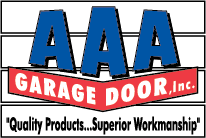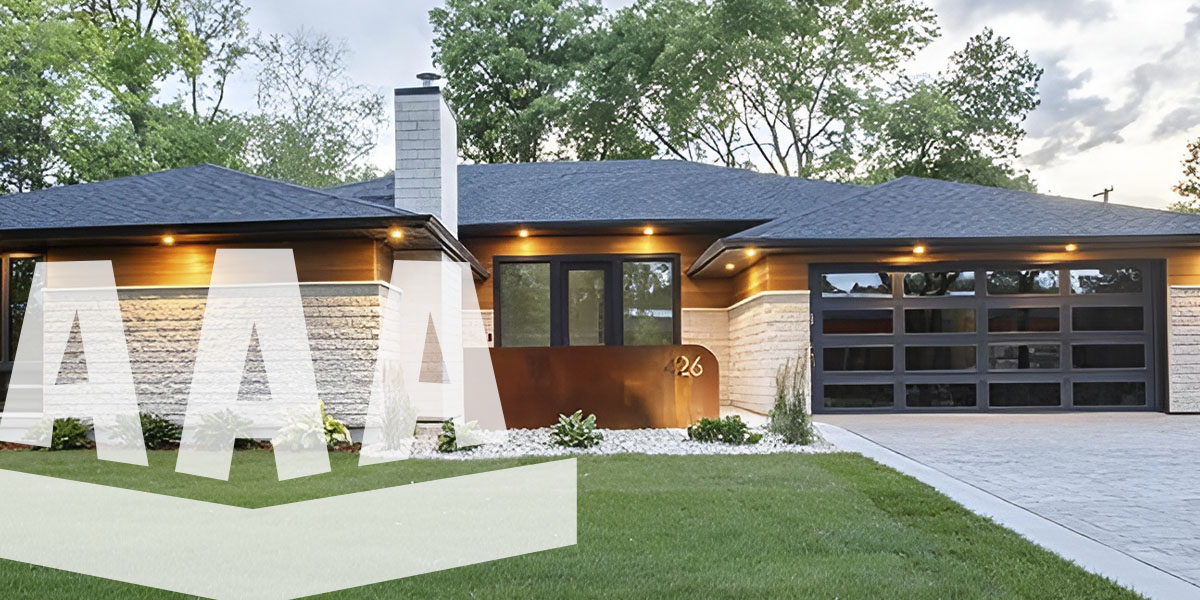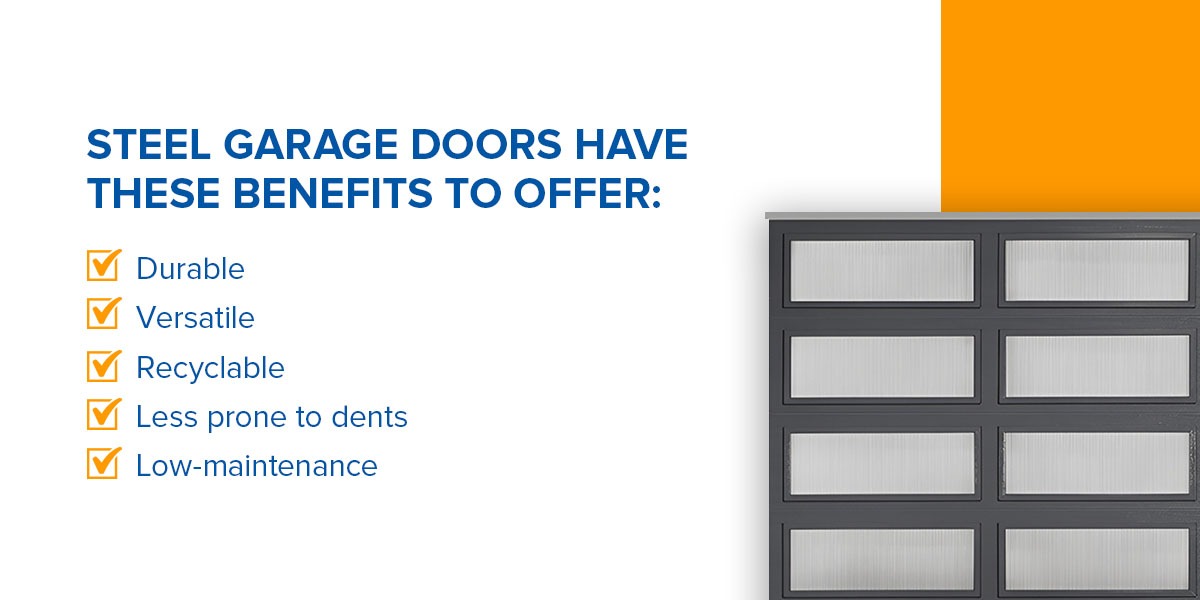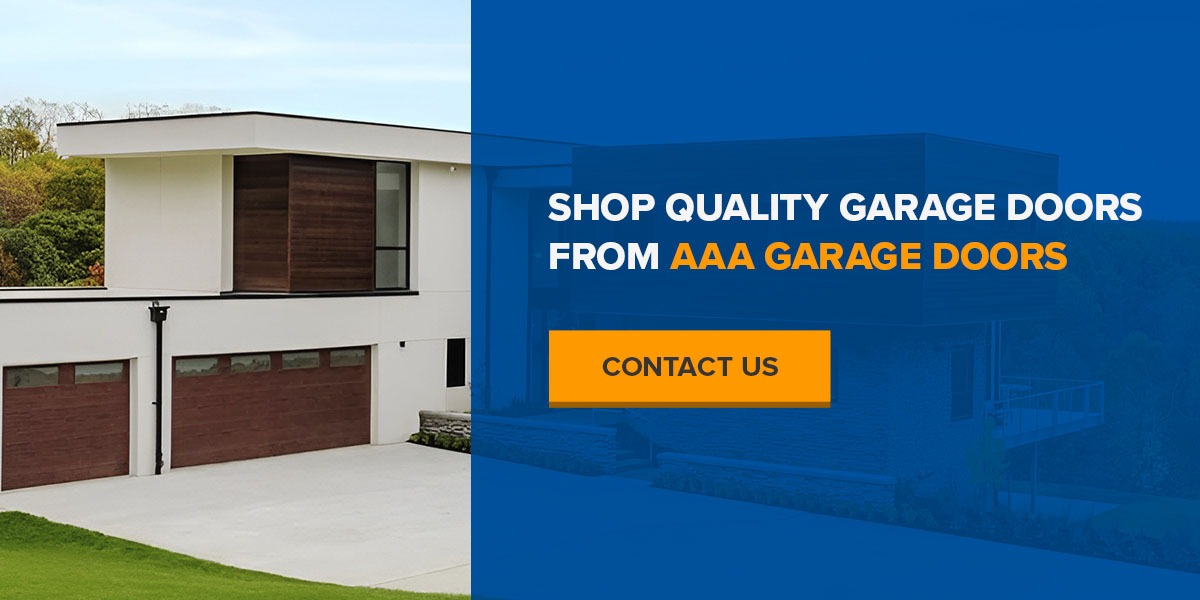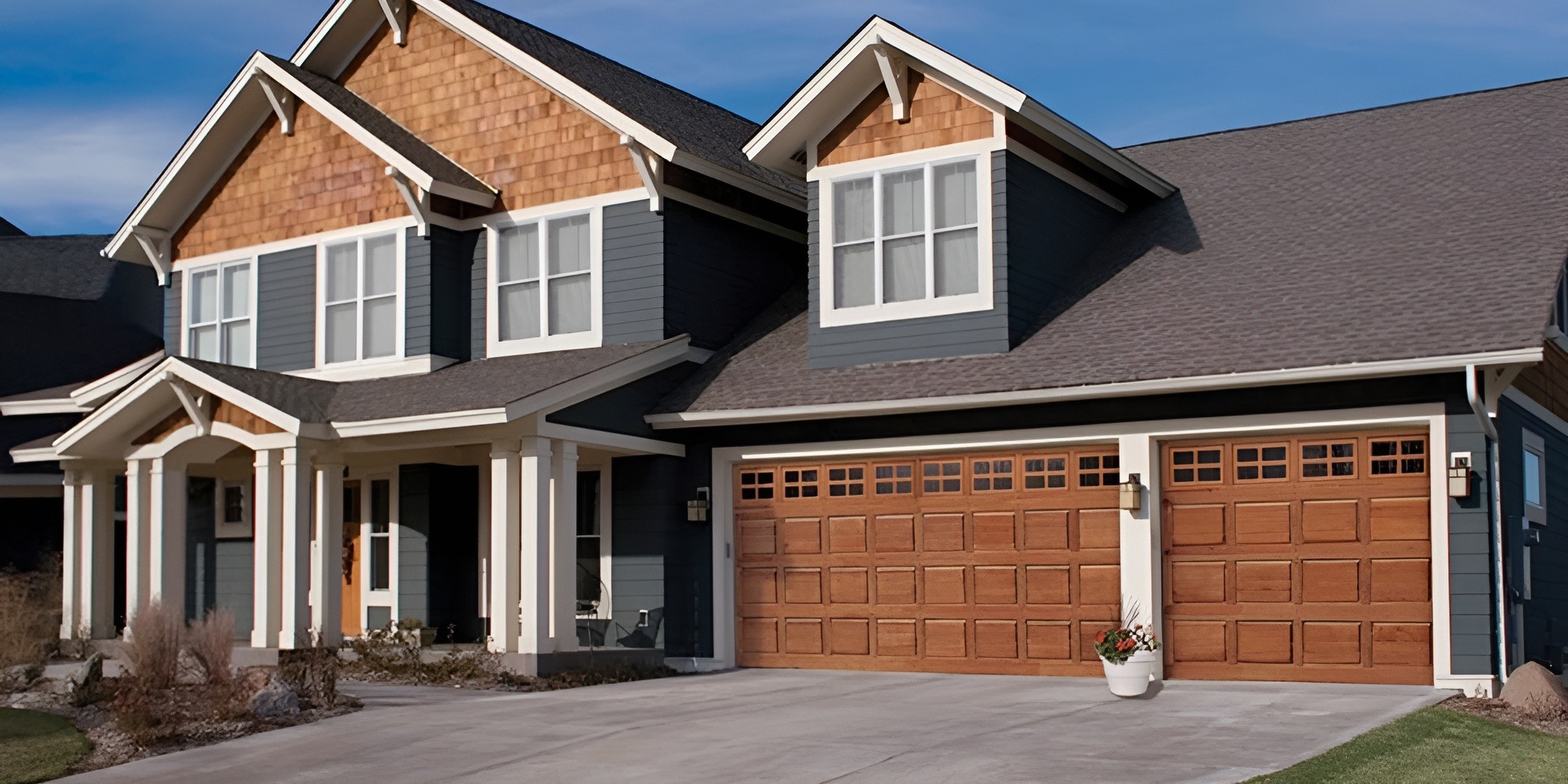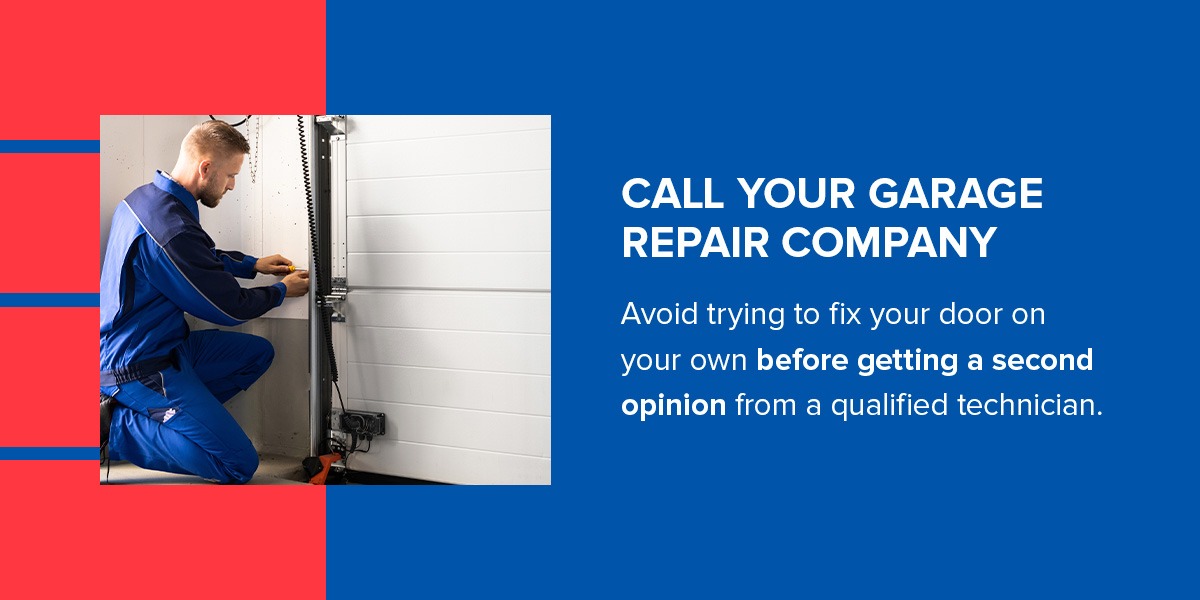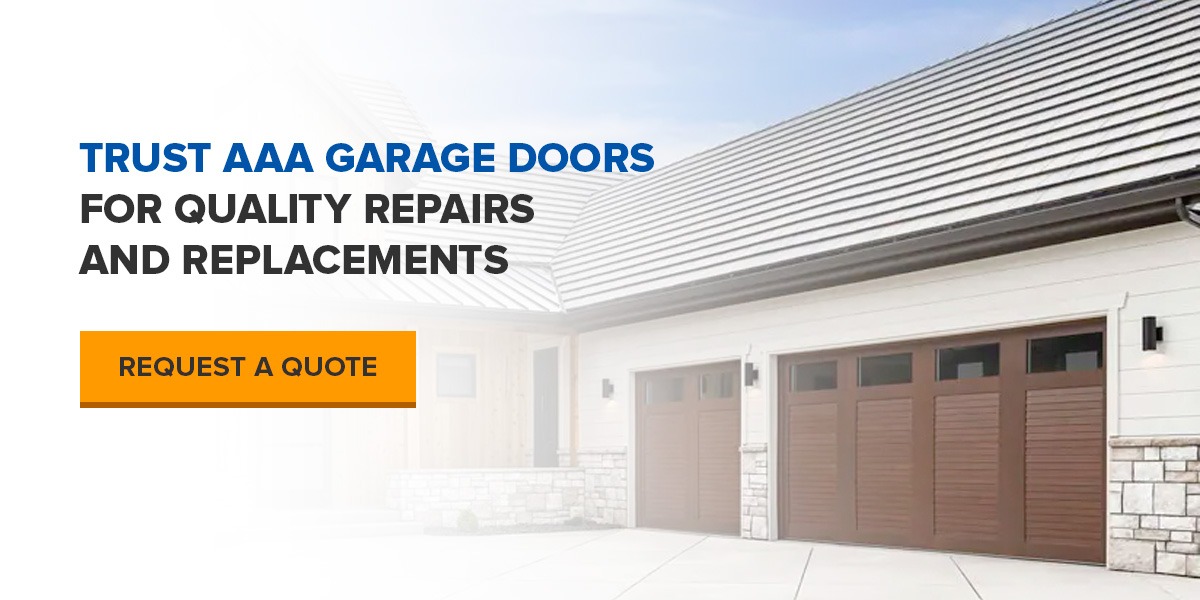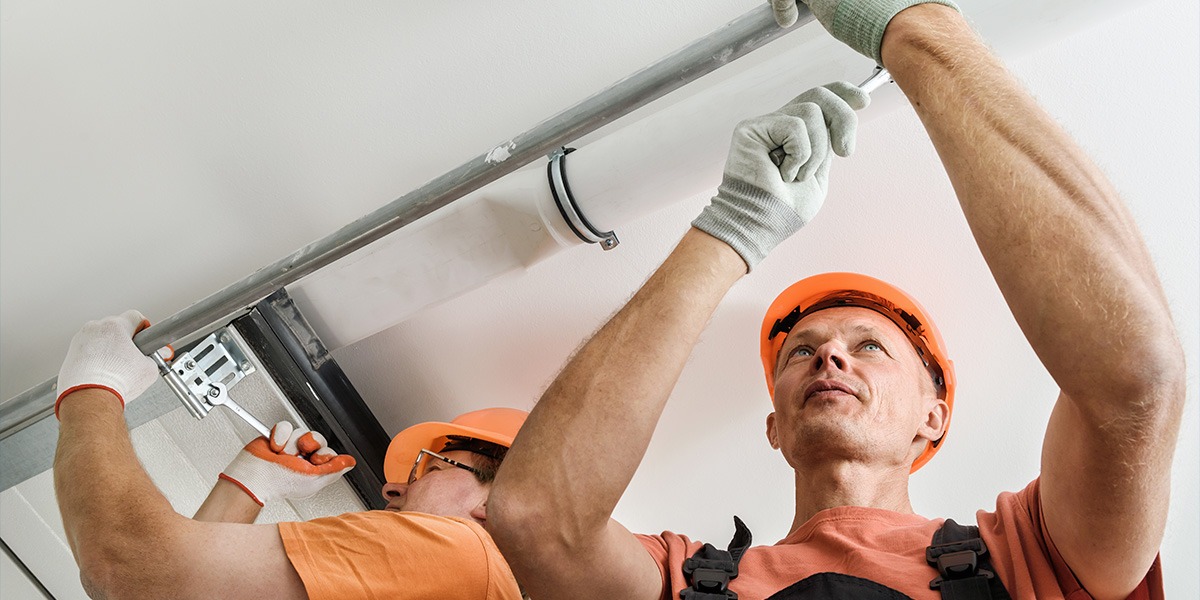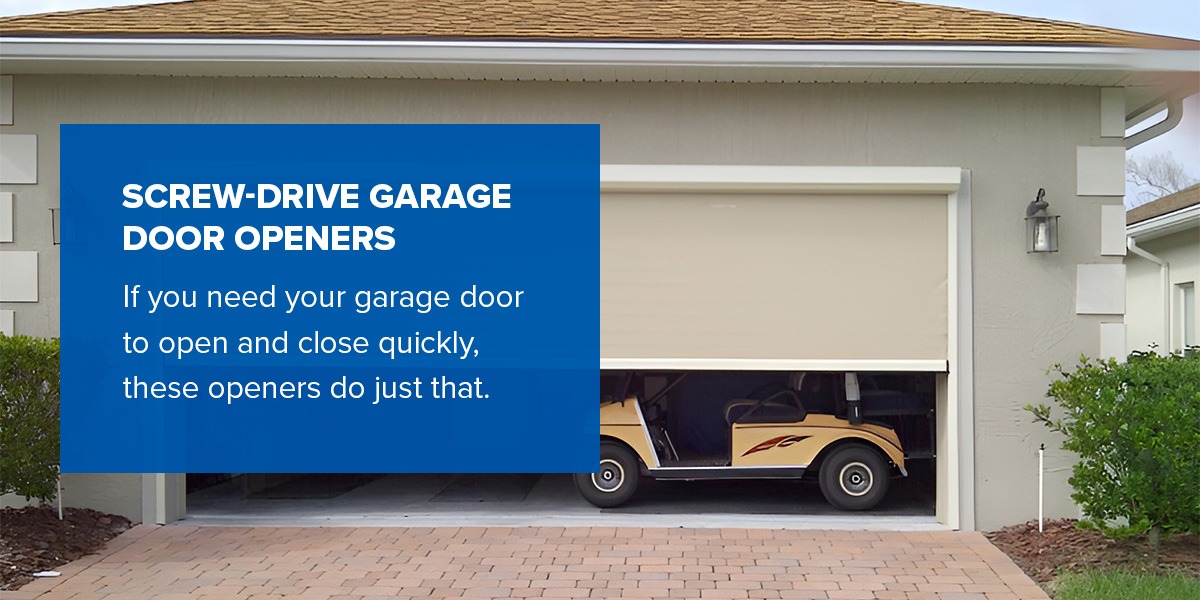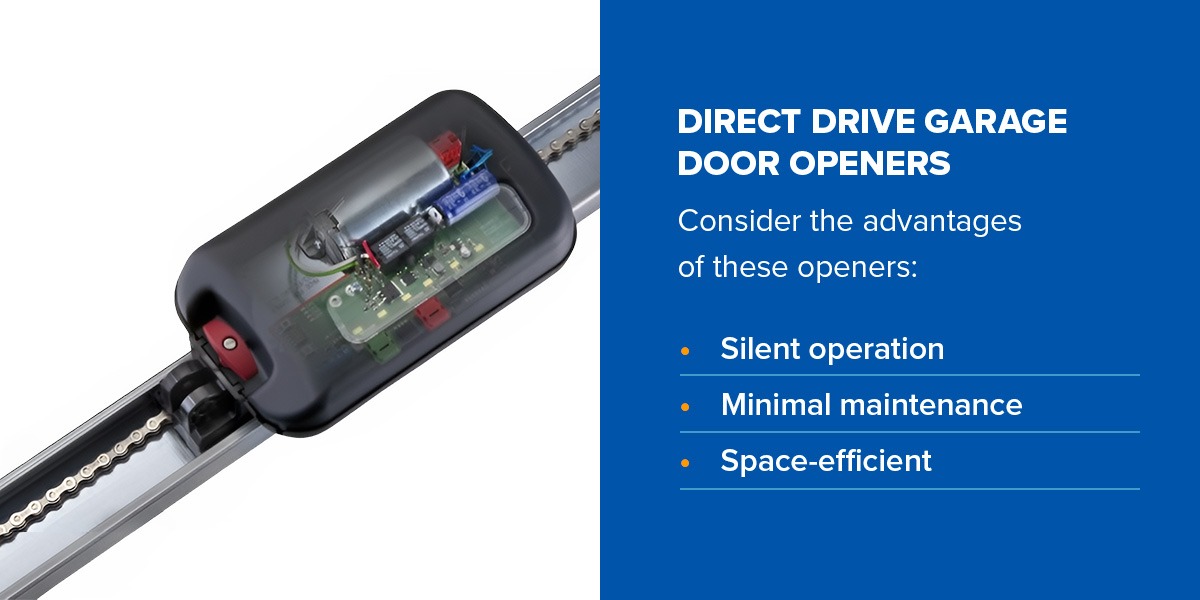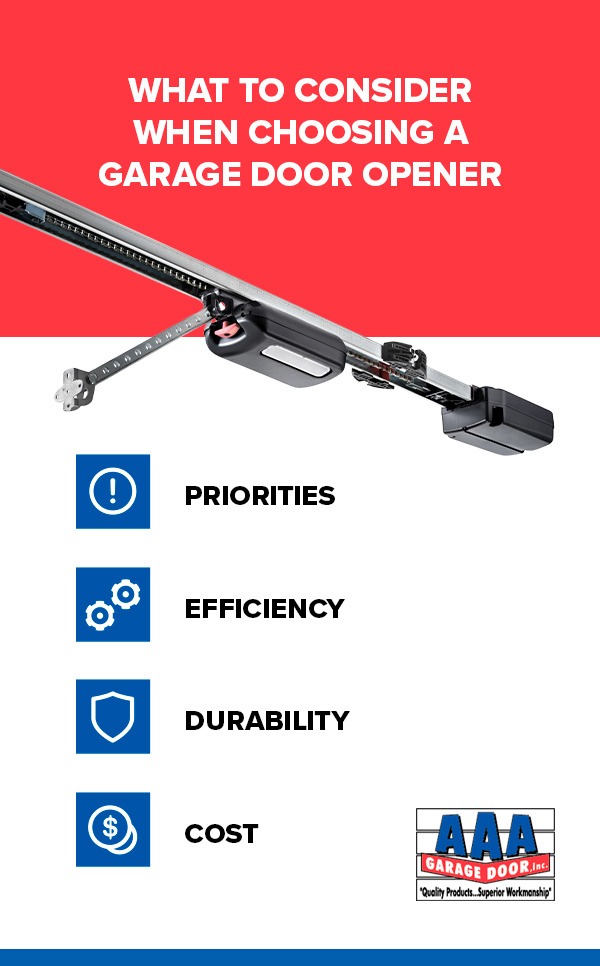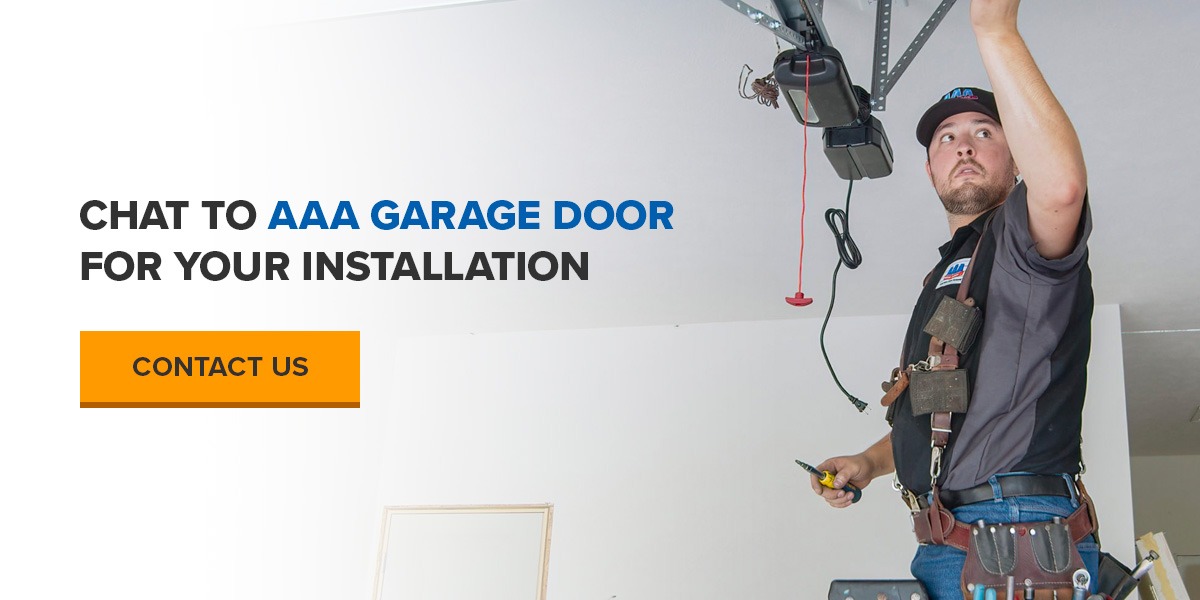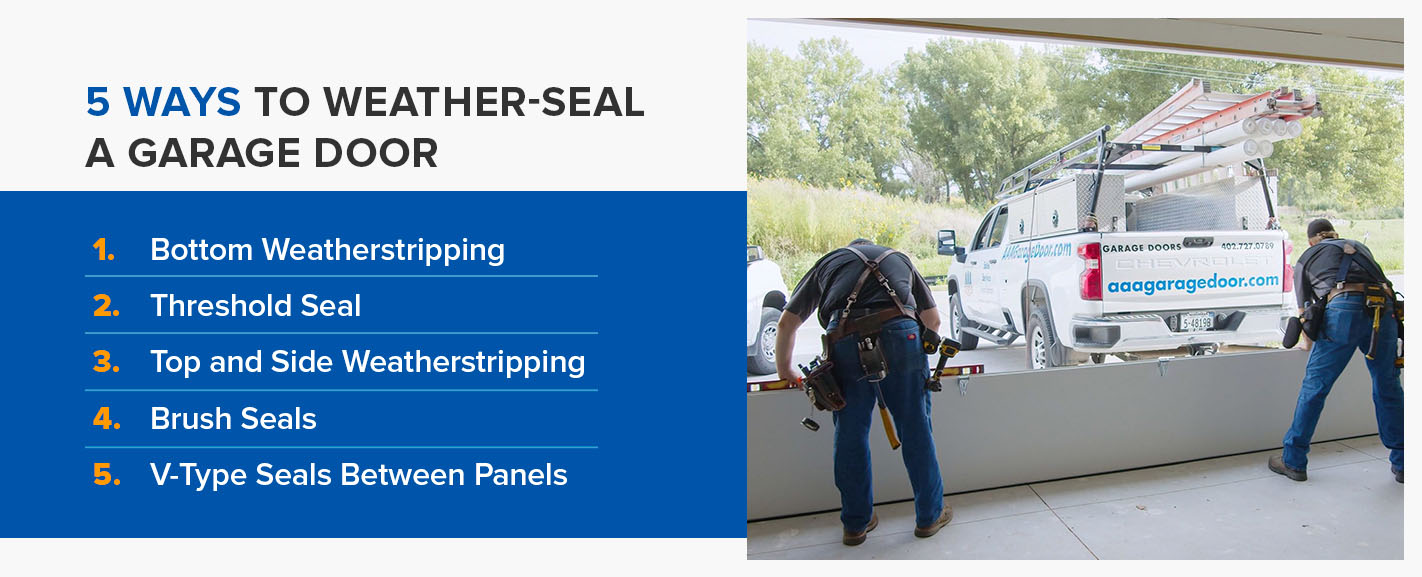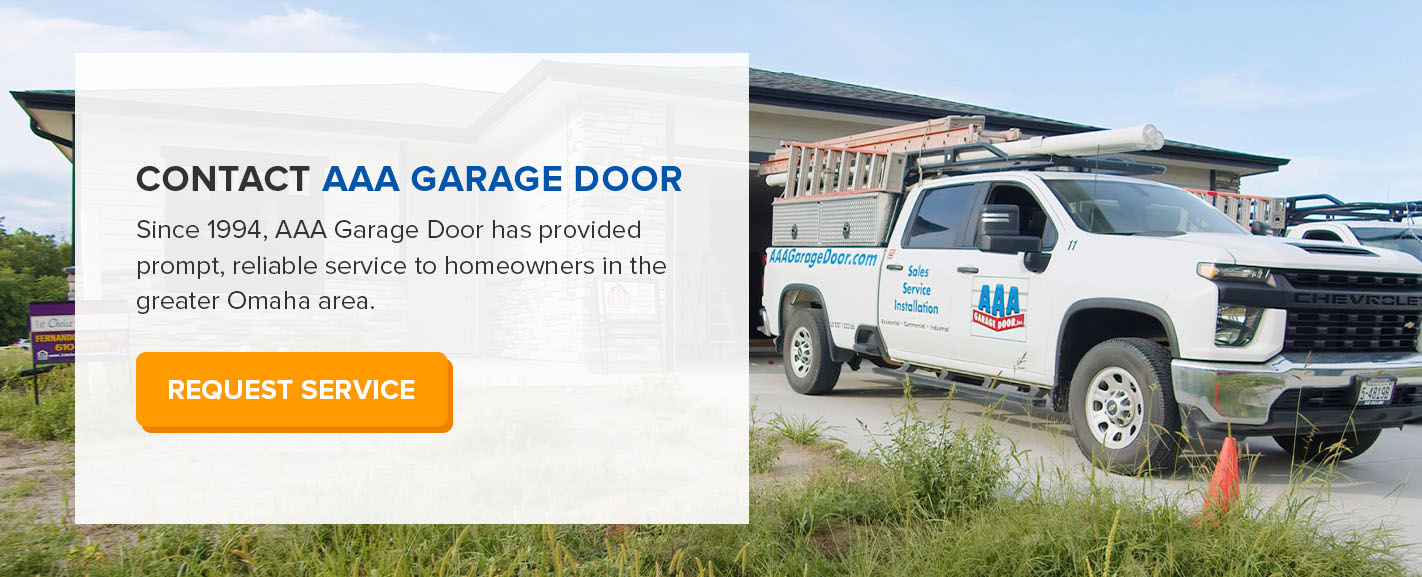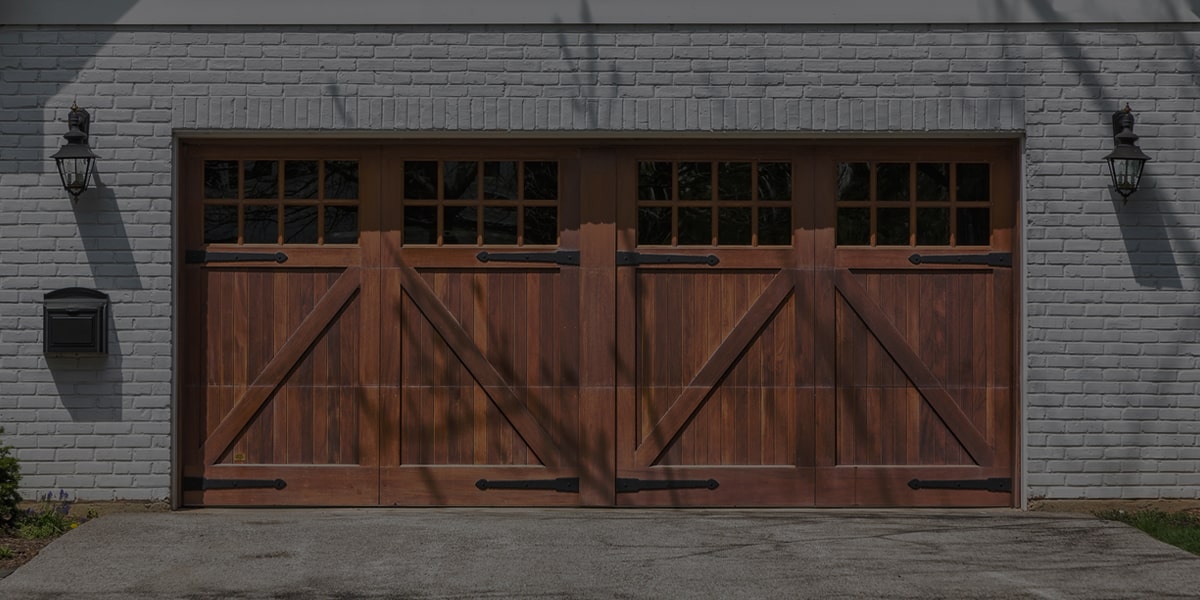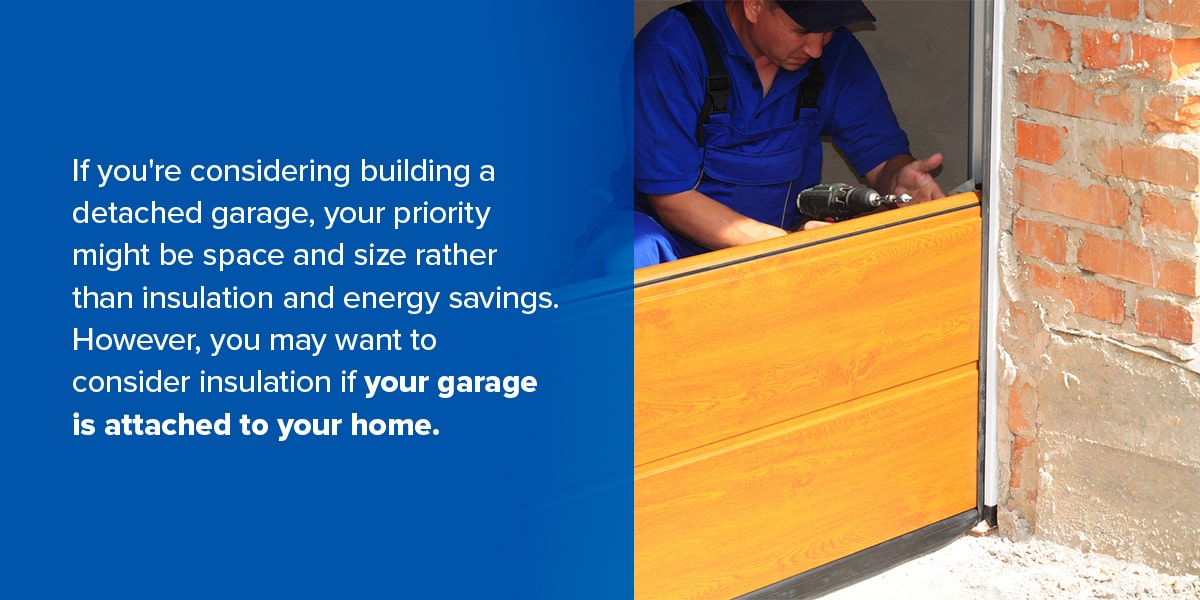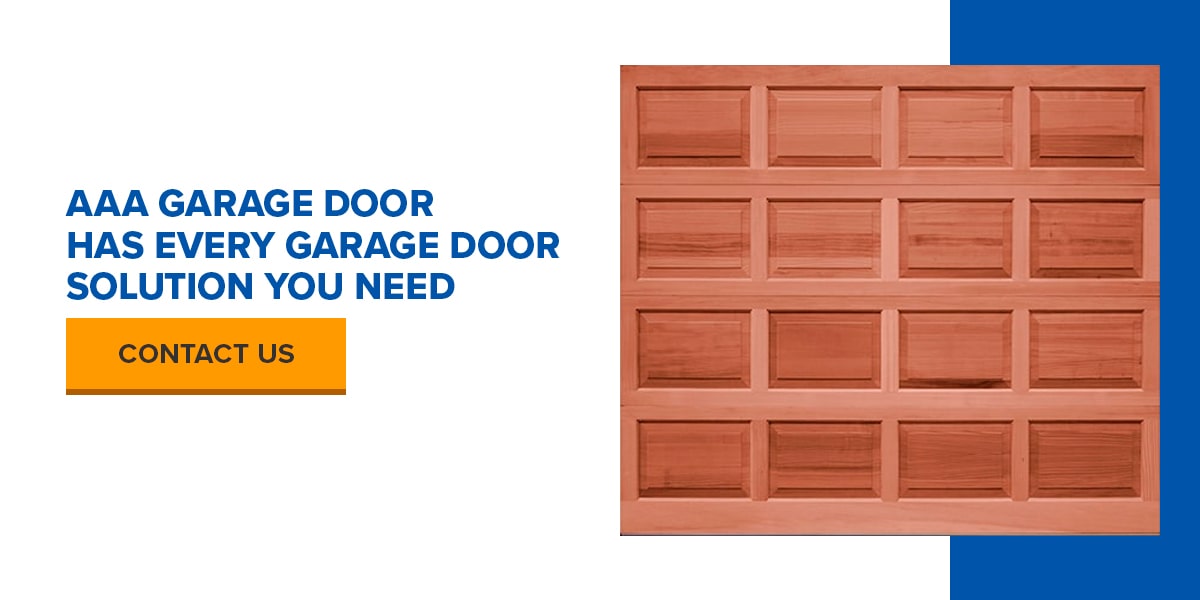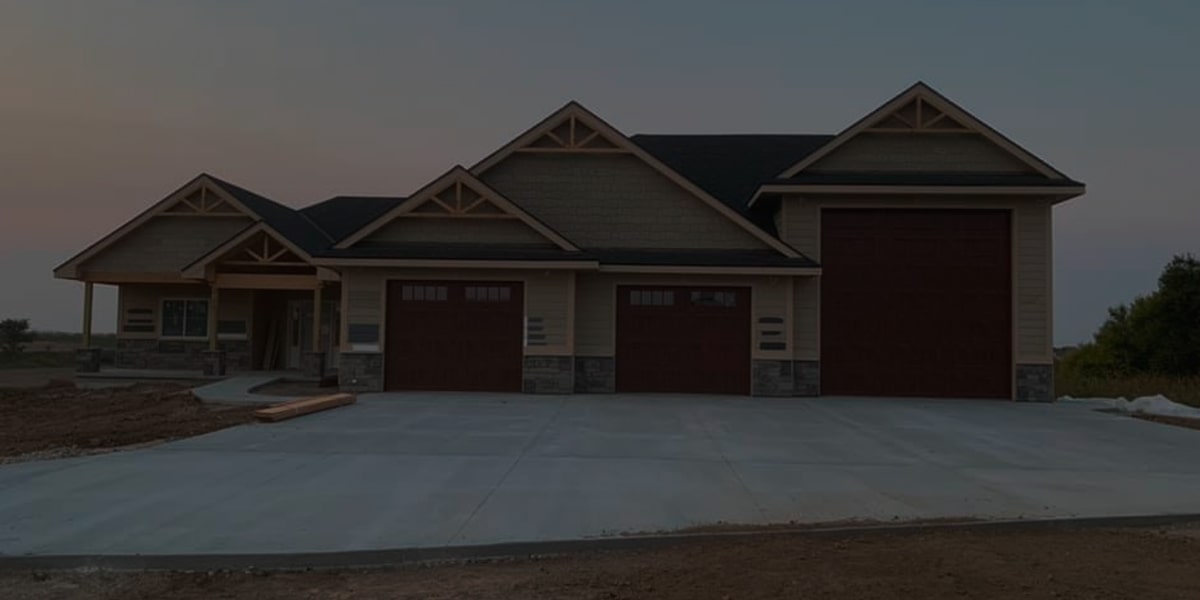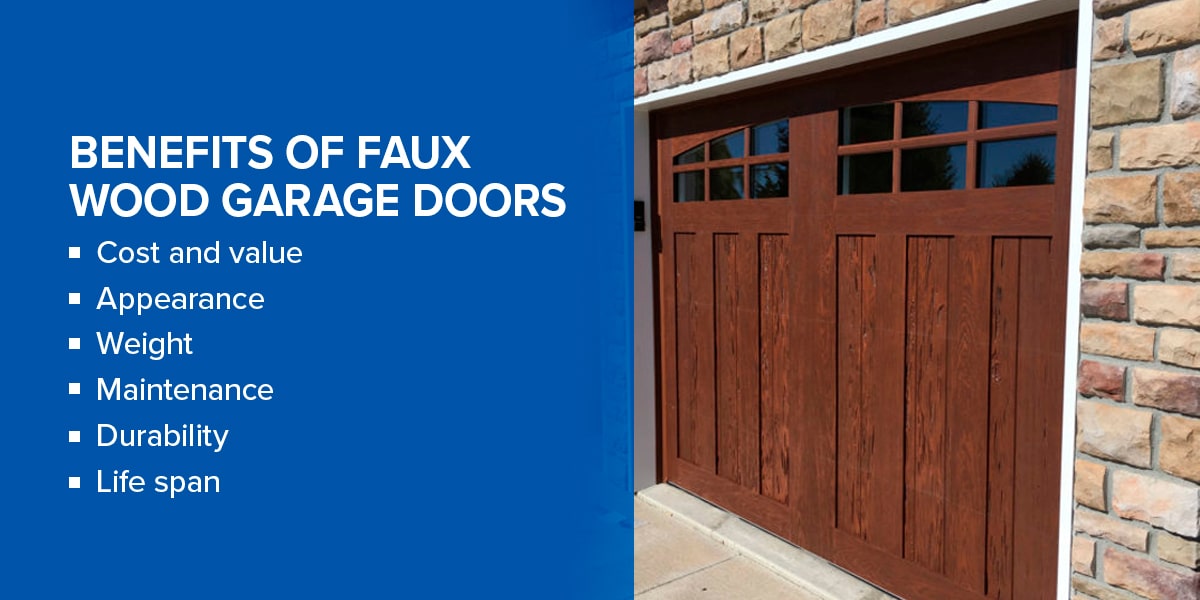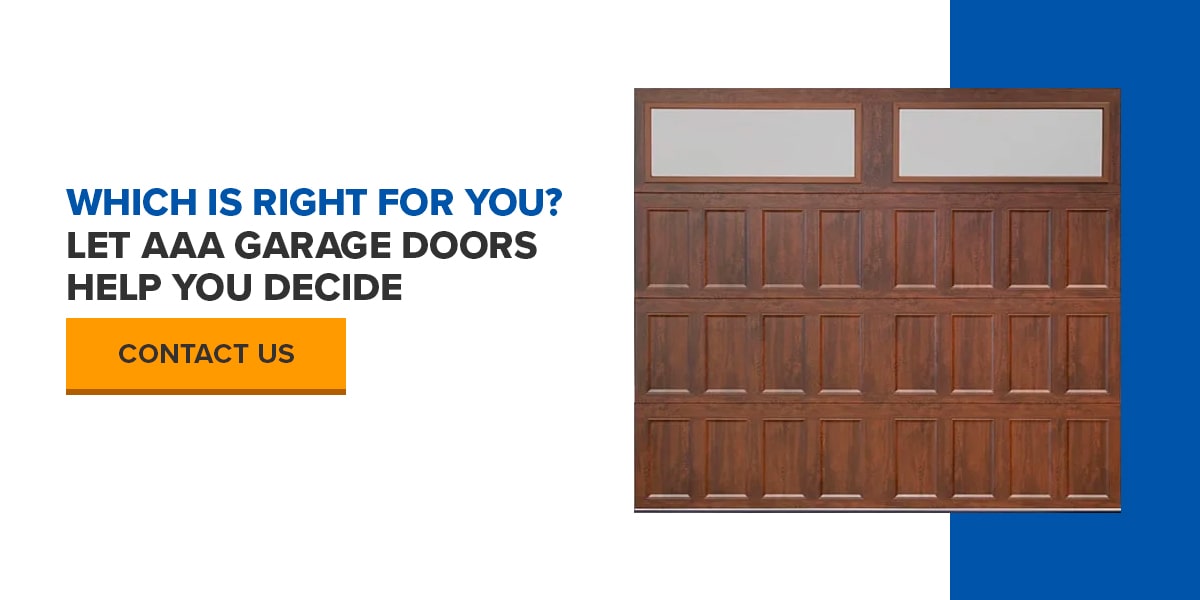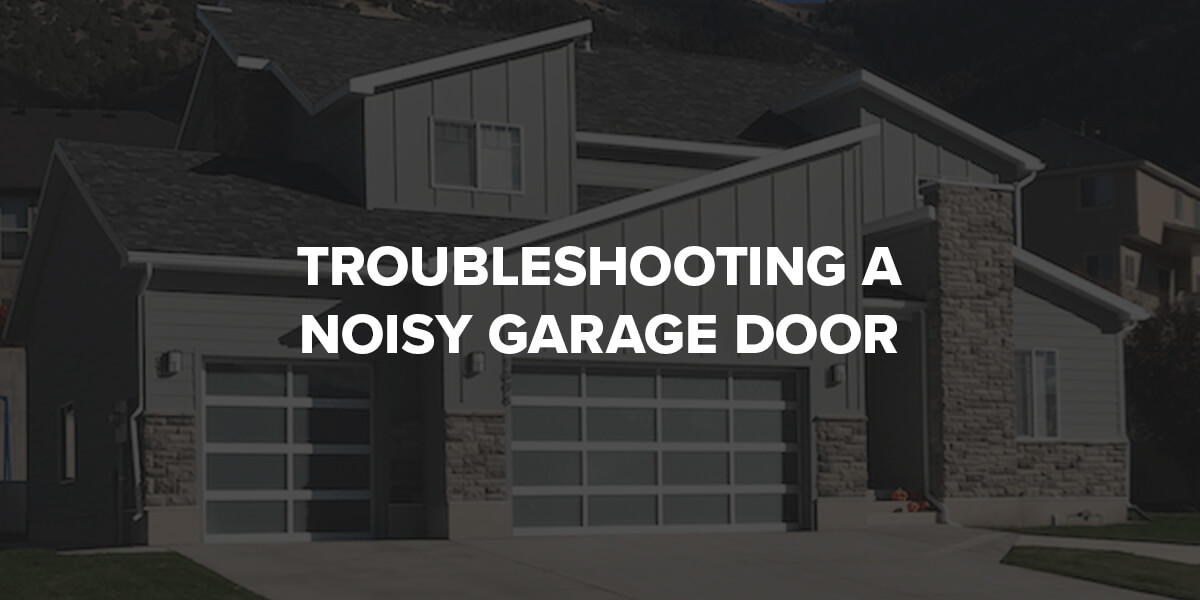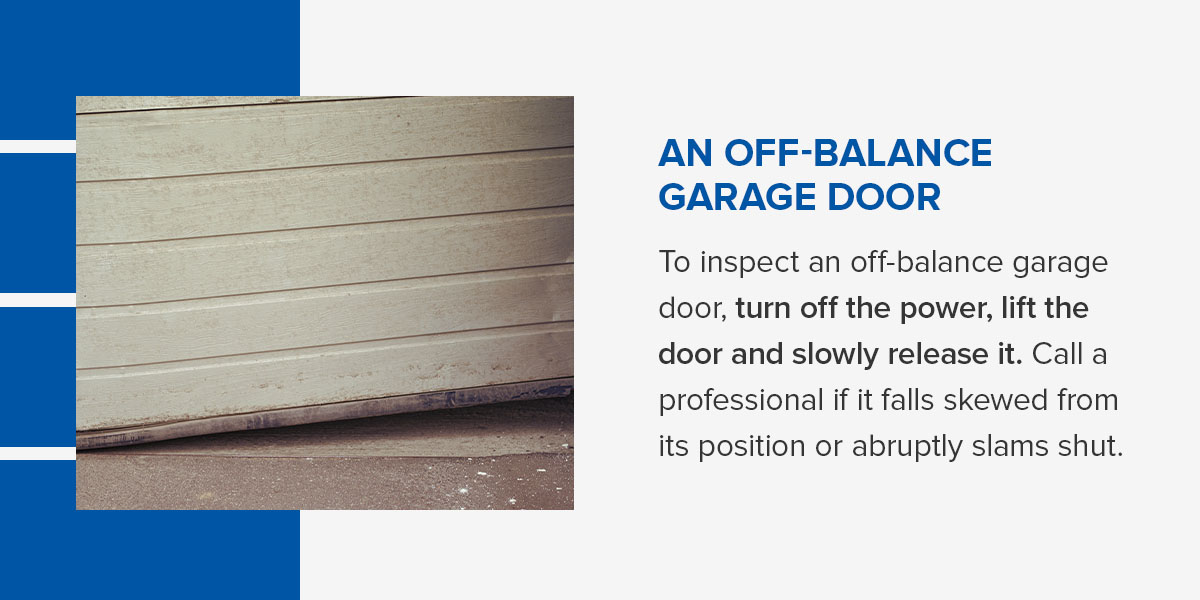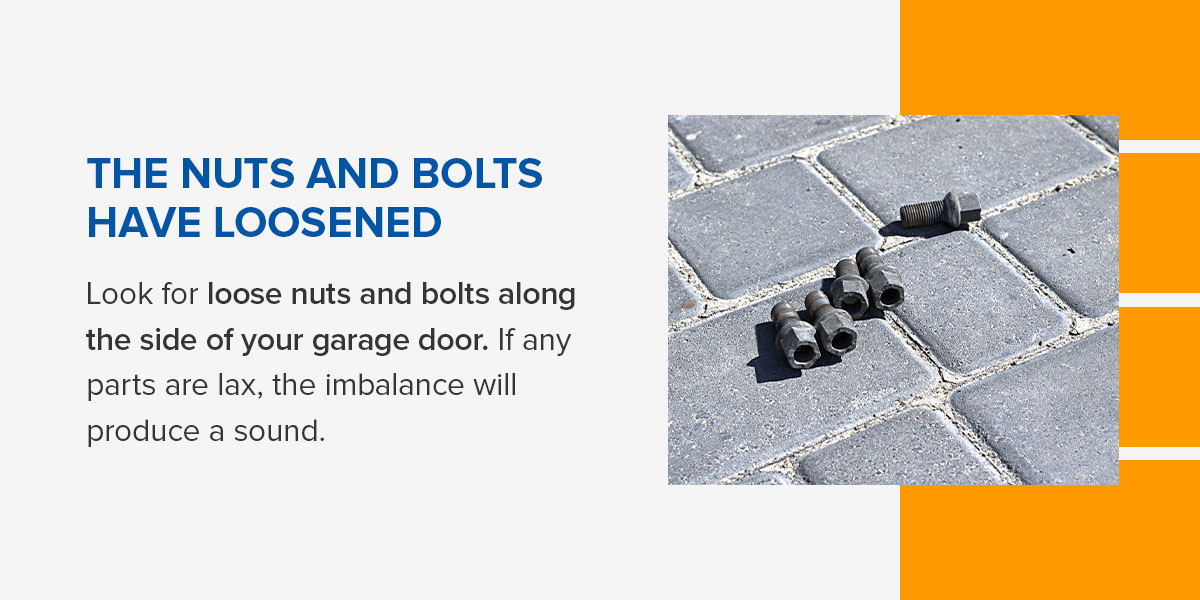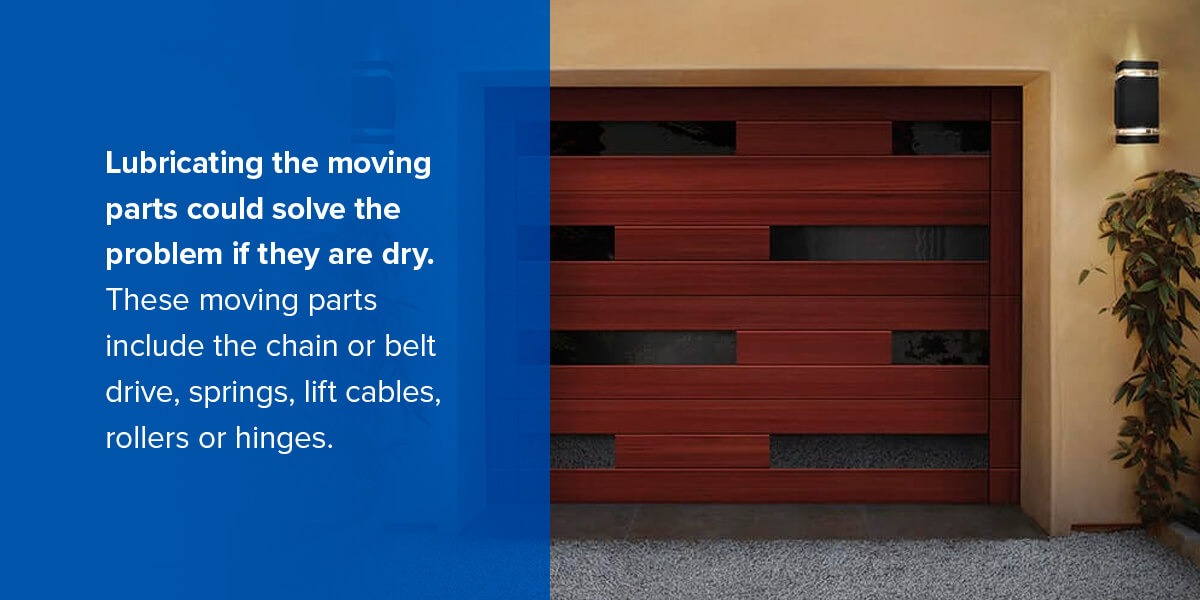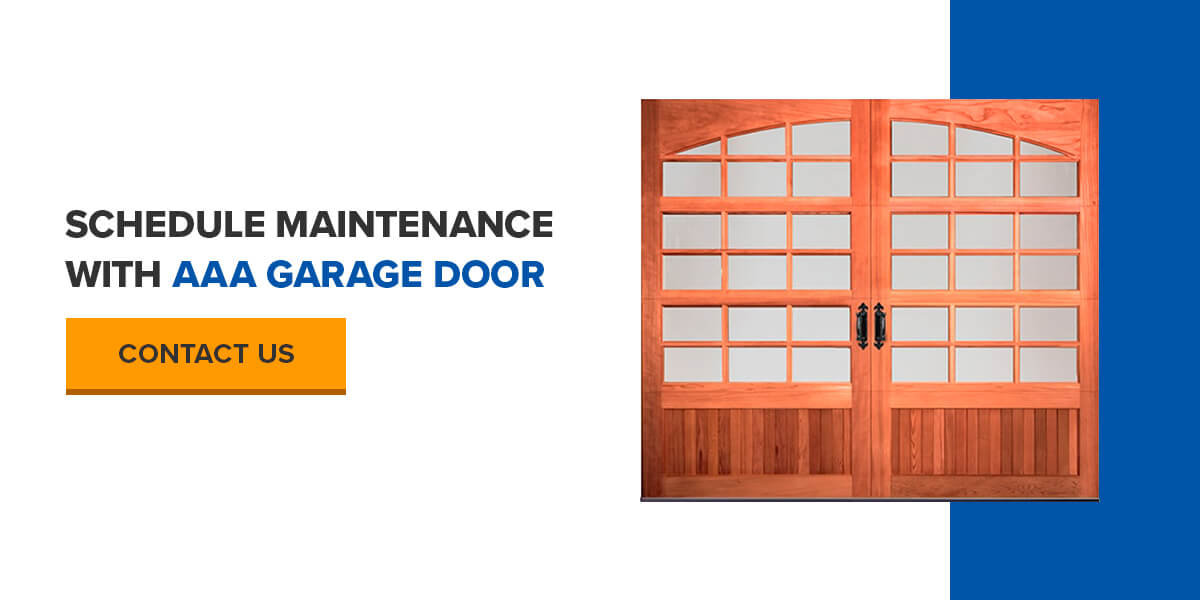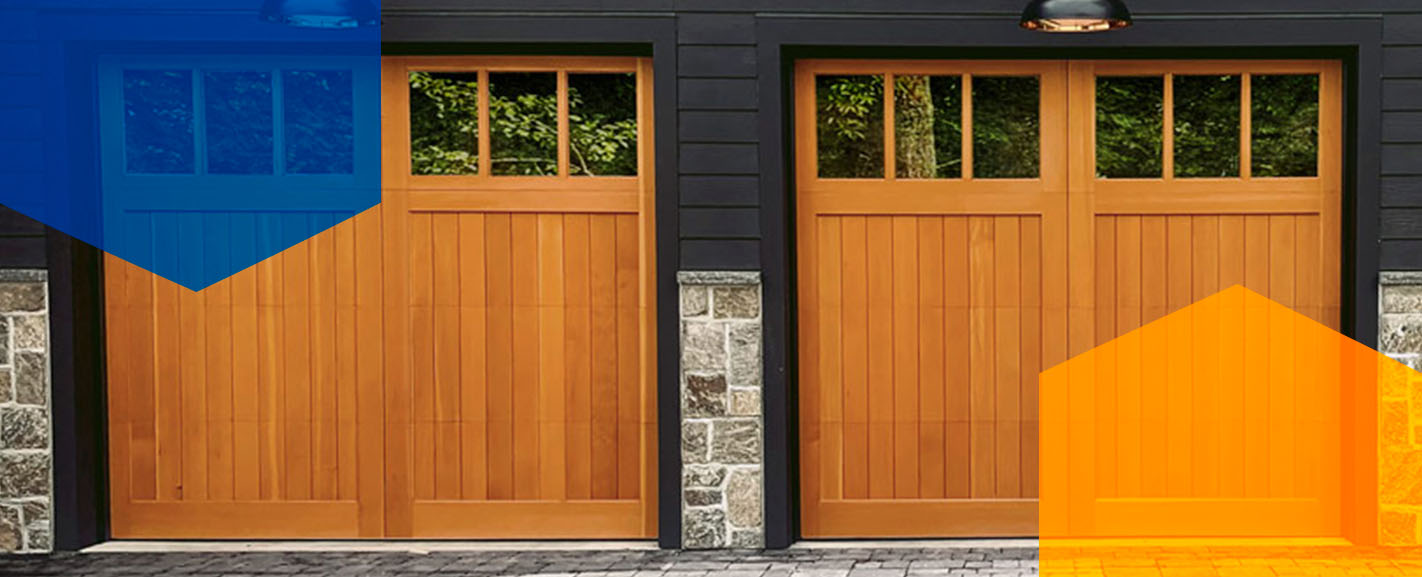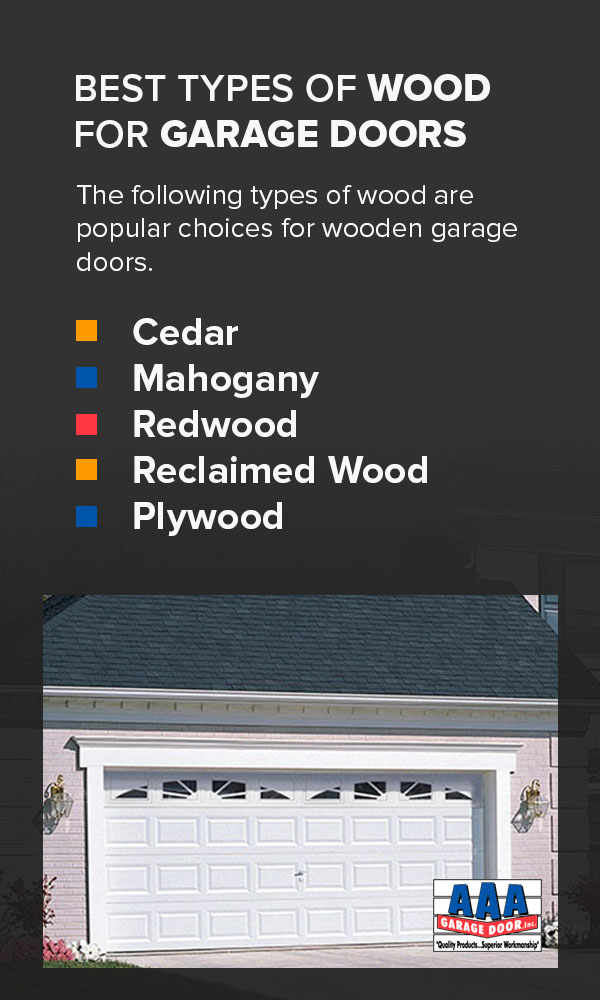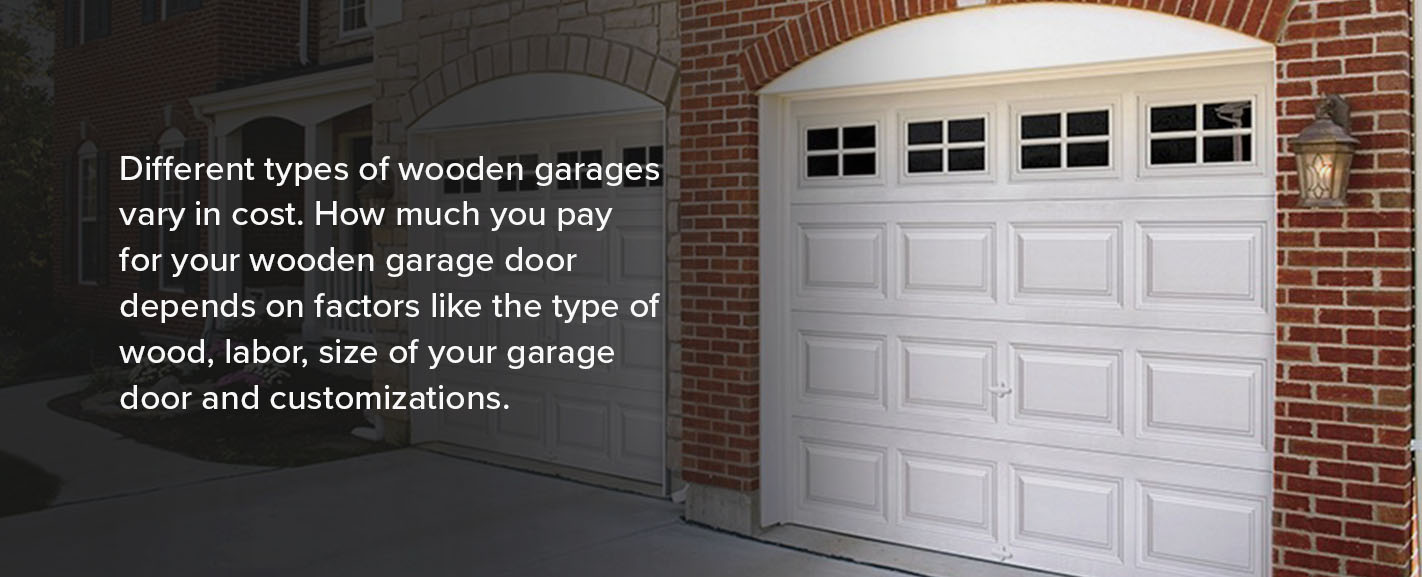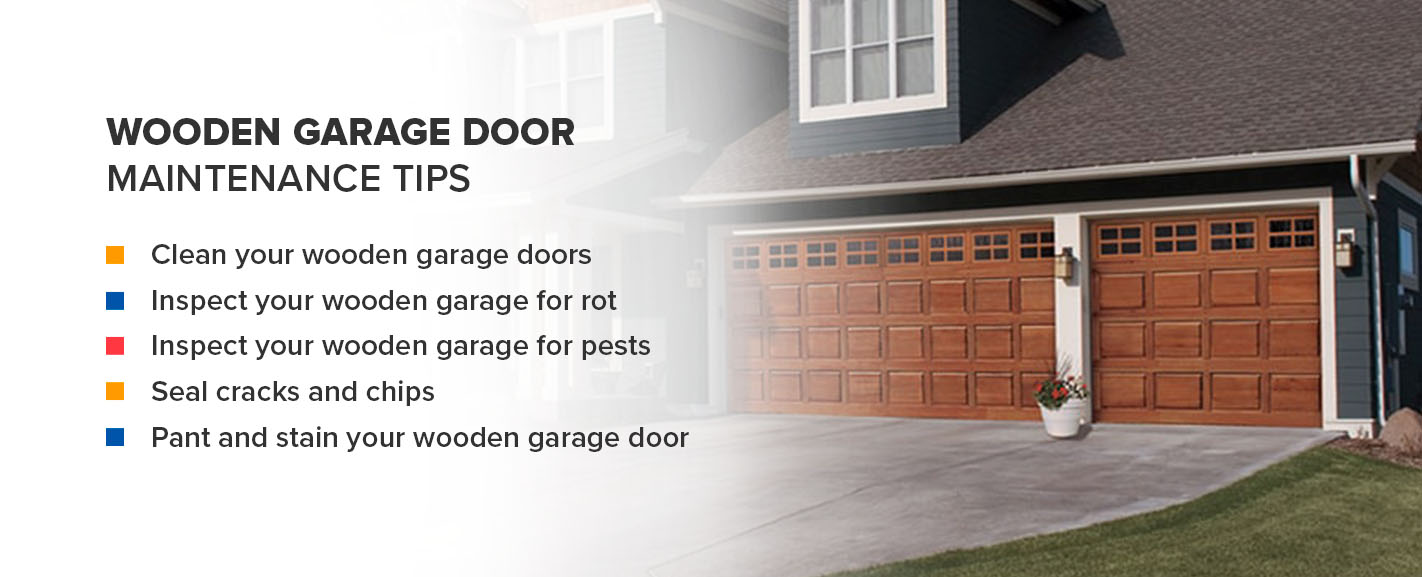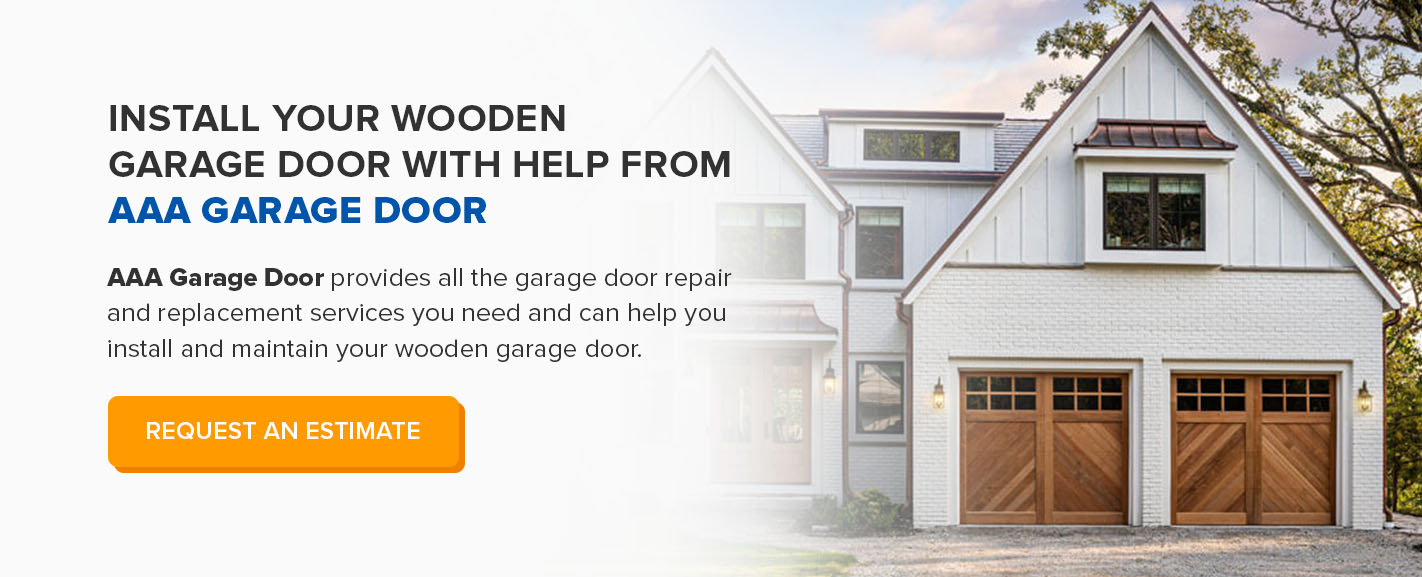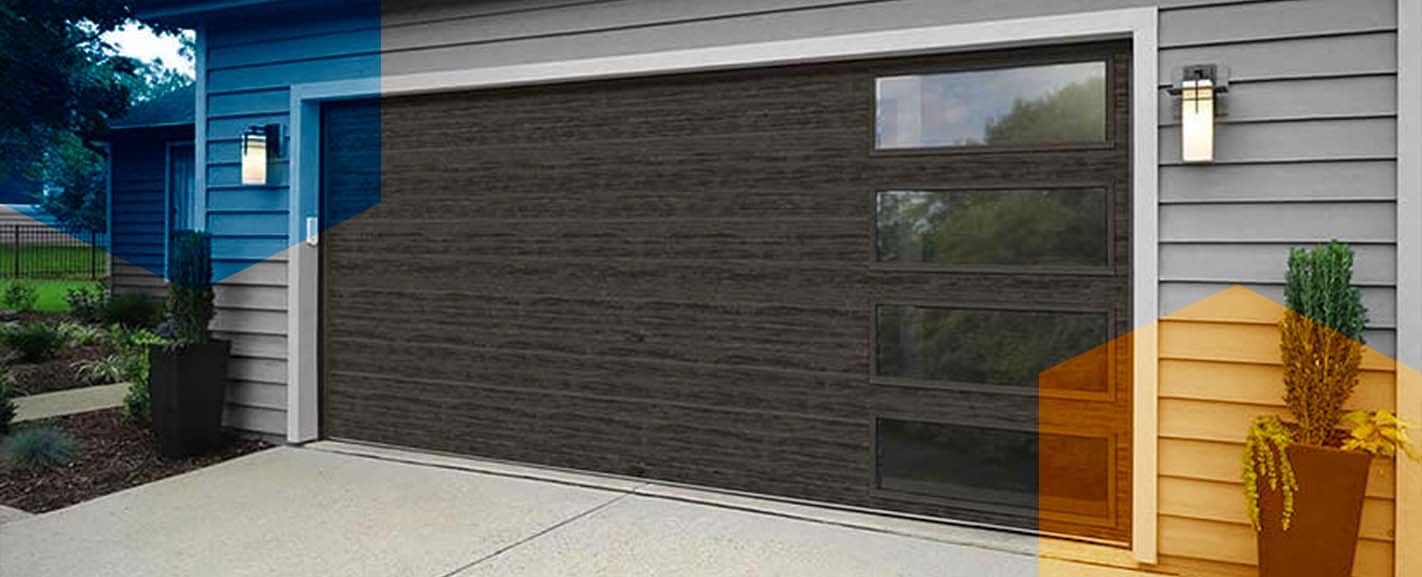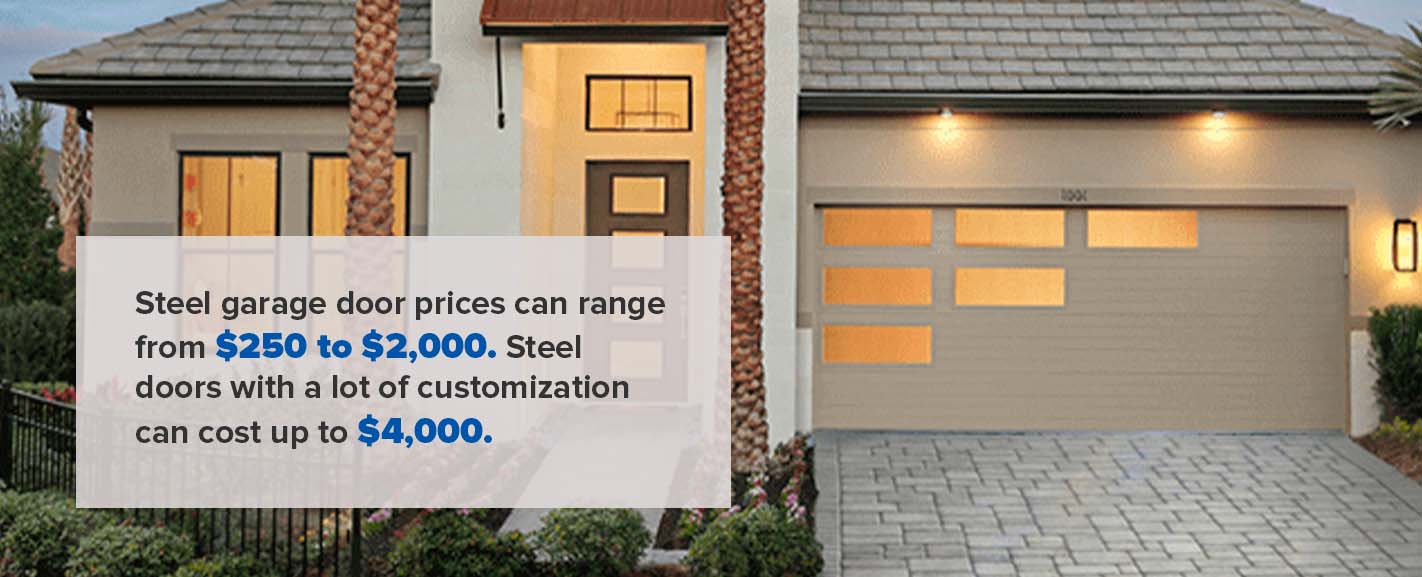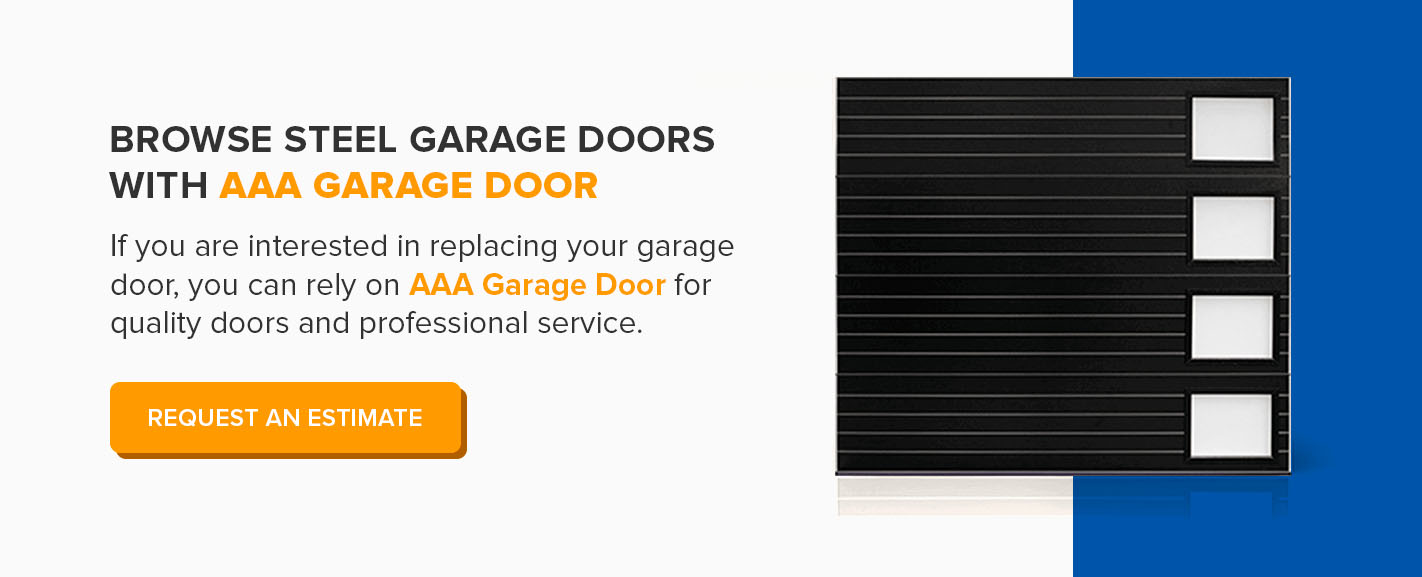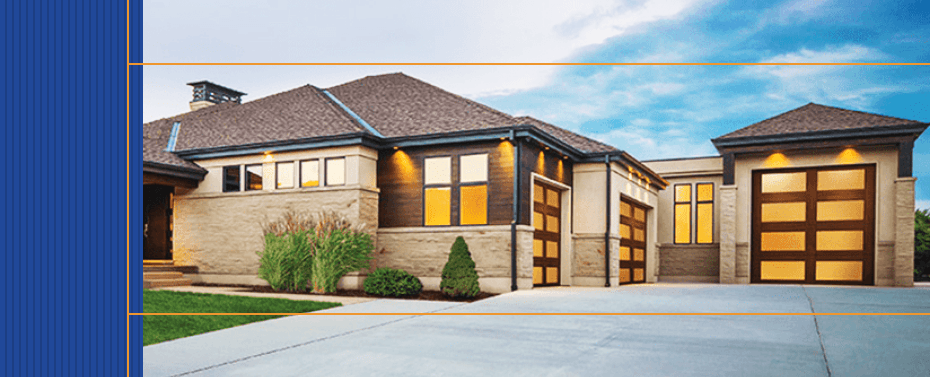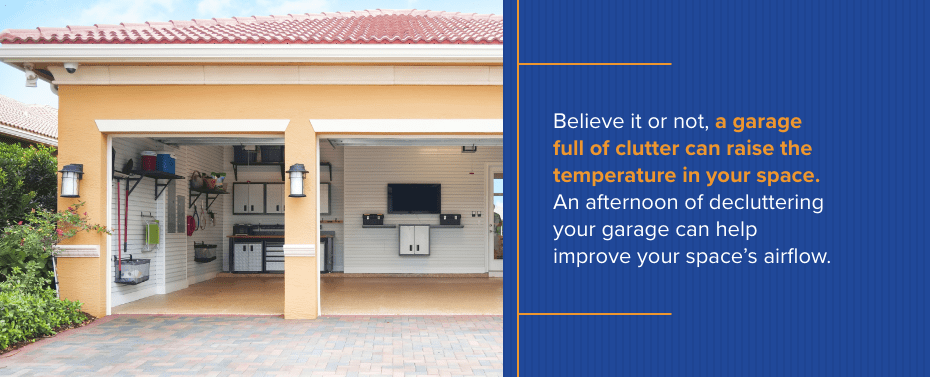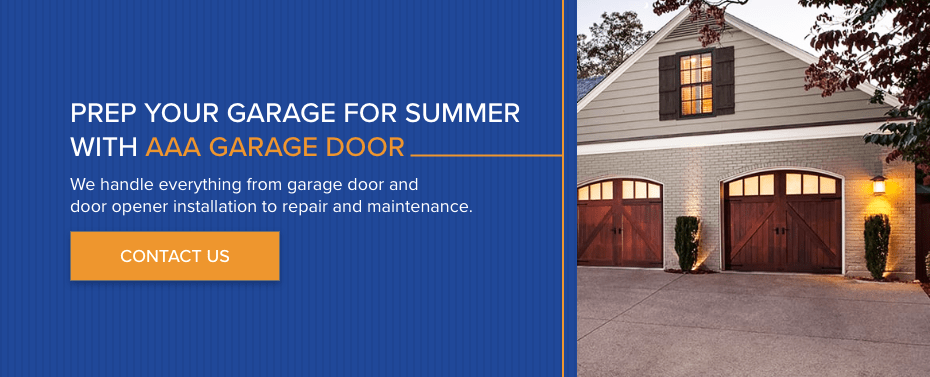Steel vs. Aluminum Garages
If you’re in the market for new garage doors, different materials offer different benefits. Some are more durable, while others are a smaller investment. Because the type of garage door you choose will impact everything from curb appeal to property value, it’s worthwhile to learn what each has to offer.
In this comparison guide, we’ll explore the benefits of aluminum vs. steel doors so you can make an informed investment for your home.
Table of Contents
- Are Steel or Aluminum Garage Doors Better?
- Factors to Consider When Choosing a New Garage Door
- Shop Quality Garage Doors from AAA Garage Doors
Are Steel or Aluminum Garage Doors Better?
Steel is the heavier, more durable option, while aluminum is a softer, lightweight metal. Even though steel is more robust, aluminum still holds a superior strength-to-weight ratio. Both metals are on the more affordable end of the garage door material spectrum. They are both durable and work well in a variety of climates.
Still, deciding which is best for your home depends on various factors. Each of these garage door materials has unique benefits to offer.
Benefits of Steel Garages
Steel is an alloy of iron and carbon. It contains less than 2.00% carbon, about 1.00% magnesium and smaller amounts of silicone, oxygen, phosphorus and sulfur. Steel is an essential metal in engineering and construction.
Steel garage doors have these benefits to offer:
- Durable: Steel is a heavier, more robust metal that can withstand a lot of wear and tear over time.
- Versatile: Steel garage doors come in various styles and designs and can manage all finishes. It can be shaped around glass panels or used to make sectional garage doors or even the traditional roll-up style.
- Recyclable: Steel production is more eco-friendly than many other materials because the metal is recyclable.
- Less prone to dents: Steel’s durable properties make it less likely to dent. Driving into the door will likely leave marks, but minor impacts shouldn’t affect the surface. The panel beating process also makes it possible to remove dents rather than replace the door.
- Low-maintenance: Pre-painted steel doesn’t require much maintenance. Spraying the door panel with a hose will keep it clean all year round.
With steel garage door selections, you can choose one to four-layer constructions. The more layers, the more durable the garage door will be. Additional layers also improve insulation.
Benefits of Aluminum Garages
Aluminum is a silvery-white metal used in residential homes, automobiles, trains and more due to its versatility and playability. It is the most widespread metal on the planet, accounting for over 8.00% of Earth’s crust.
When used to craft garage doors, aluminum offers homeowners the following benefits:
- Lightweight: Because aluminum is a lightweight metal, these garage doors are easier to install. The lighter weight also ensures the garage door opener is under less strain, so the opening system will last longer and likely require less ongoing maintenance.
- Corrosion-resistant: Aluminum garage doors are unlikely to rust and corrode due to the metal’s natural properties.
- Recyclable: This metal is recyclable, making it a more eco-friendly option than some materials.
- Low-maintenance: An aluminum garage door is effortless to maintain. You’ll only need to spray the garage door panel with a hose to keep it clean.
- Scratch-resistant: This metal may be more prone to denting, although it is scratch-resistant.
Aluminum garage doors offer valuable benefits and can be more versatile than steel. But when aluminum doors dents, you may need to replace it. Panel beating is not suitable because this process can cause the metal to stretch and weaken.
Factors to Consider When Choosing a New Garage Door
Before investing in a garage door for your home, there are a few crucial factors to consider, from short- and long-term costs to property value and more. These factors will help you decide which material offers the best investment.
Short-Term and Long-Term Costs
Metal garage doors have similar price ranges, and several factors impact these prices, including size, style and finishes.
The repair costs between steel and aluminum garage doors are also similar, with aluminum repairs being slightly more affordable in general. Both types of garage doors can last up to 30 years with routine maintenance and care, although steel doors will wear down garage opener systems quicker due to their heavier weight. So, steel may come with higher long-term maintenance costs.
Curb Appeal
Both aluminum and steel garage doors are versatile options for boosting curb appeal. You can customize them with things like glass windows, different colors and finishes, hardware and insulation. However, aluminum is a lighter, more flexible metal, so customization is easier. As a result, customized aluminum garage doors are often easier to find.
Because a new garage door boosts curb appeal and offers security and functionality, either metal can provide a 102.7% return on investment when it comes time to sell your house.
Home Security
Garage doors offer a lot in terms of home security. The garage door secures the largest entrance to your home and the most valuable space. However, steel is a superior material when choosing a garage door to enhance safety. Because aluminum is lightweight, it is easier for criminals to break through and enter your home. Steel, on the other hand, offers maximum security.
Even so, it’s still important to be safety conscious when investing in a steel door. Installing a garage security system is wise, and upgrading the opener system is also important. Automatic garage door openers can boost safety, as the remote signals cannot be copied. Newer models send new code signals each time the door is opened or closed, making it harder for criminals to enter your home.
Temperature
When it comes to managing indoor temperatures, insulation is essential. Because steel is heavier in weight, it can offer more insulation than aluminum. Steel is also more durable against harsh weather conditions.
Aluminum has a higher thermal conductivity than steel, meaning it will transfer heat more efficiently. Aluminum doors may improve indoor temperatures in winter by absorbing heat from the winter sun and transferring it into your home through the garage. Even so, steel is a superior choice to boost home insulation. When choosing either material, insulating your garage doors is the best way to help regulate indoor temperatures and keep utility costs low.
Shop Quality Garage Doors from AAA Garage Doors
Whether you choose lightweight aluminum or durable steel garage doors for your home, AAA Garage Doors offers a wide range of quality garage doors. But if you still aren’t sure which material is the best choice, reach out to our garage door experts at 402-307-8013. We’ll recommend the best options for your home, budget and lifestyle.
Browse our range of garage doors and garage door openers and request an estimate online.
Ran Into Your Garage Door? Here’s How to Fix It
As a homeowner, you have much to think about and often little time to get through everything. It can be easy to get caught up in your to-do lists, phone calls and planning, so much so that you reverse out of your home and accidentally back into your garage door while it’s still opening.
Now you’re either at a standstill or panicking, processing what happened and what to do next. While this situation can be overwhelming, the good thing is you can resolve it quickly and safely, get your door back in working condition and your life back on track.
Table of Contents
- What to Do if You Hit Your Garage Door With Your Car
- Common Issues Caused by Backing Into a Garage Door
- FAQS About Fixing a Damaged Garage Door
- Trust AAA Garage Doors for Quality Repairs and Replacements
What to Do if You Hit Your Garage Door With Your Car
There’s nothing worse than realizing you’ve backed your car into your garage door. It can be a hazardous and frightening situation for you and your passengers. While panicking can be a normal response, you must remain calm and handle the situation as best as possible. To help, here are eight steps to follow if you accidentally run into your garage door with a car:
1. Check on Your Passengers
Whether you have a minor or significant impact on your door, you and your passengers can sustain injuries. Calmly check yourself and your passengers to see if everyone is safe.
2. Put Your Vehicle in Park
Put your car in park and turn it off before exiting. This step is essential, as many people in a panic forget to put their vehicles in park, leading to further accidents.
3. Assess the Damage
Once you safely turn your car off, exit and asses your vehicle and garage door surface for damages. If you run into your garage door from the inside, move it forward to get a better indication of the damage. If the accident occured outside, enter the garage from an alternative door or room to check for dents or markings and avoid potential safety hazards.
4. Avoid Opening Your Garage Door Remotely
Knowing the extent of your door damage can be challenging, and it’s best to avoid opening your garage remotely. This can lead to further system damage.
5. Test the Door’s Manual Operation
If you notice minor dents and scratches on your door, try to operate or open it manually. However, if your garage door is misaligned and off the tracks, avoid moving or operating it manually, as it could collapse.
6. List the Damages
Make a list of visible damages and track misalignment, broken panels and dents to report to your repair company before they give you an estimate. You can also measure the dents and list the material damage to give technicians a better idea of the extent. If your garage door is off the tracks, keep an 8-foot distance until you get someone to repair the damage.
7. Call Your Garage Repair Company
Whether you have minor or significant garage door damage, call your repair company and explain all the faults listed. They’ll inspect your door and ensure it is safe for use and do repairs and replacements if needed. Avoid trying to fix your door on your own before getting a second opinion from a qualified technician. A garage door that is off its tracks can require complex repairs, and attempting to fix it can lead to injury.
8. Decide on Repairs and Replacements
After a professional inspection, you can decide if you need repairs and replacements. If it has minor dents and scratches, get a quote from your repair company to determine what you can afford to fix. Significant damage, like a door replacement, can be more costly and require filing a claim on your homeowners insurance policy. Remember to contact your car insurance company and find out if you are covered for any vehicle damage.
Common Issues Caused by Backing Into a Garage Door
Knowing what to look for if you back your car into your garage door can help determine the severity of the damage. Some common issues caused by running your car into your garage door can include:
- Scratches: You might notice paint and material scratches on the surface of your garage door. These can be minor damages you can remove or touch up with rubbing alcohol, a paint coat or a stain, depending on your garage door material.
- Broken panels: Your bottom door panels might be dented or broken and require repairs depending on the extent of the damage. A replacement might be the best solution if you have two or more damaged panels.
- Misaligned rollers: Excessive impact can cause your garage door to come off track. In this case, you might need to replace your garage door hinges and rollers.
- Misaligned or broken track: If your garage door track is damaged, it requires extensive repairs and replacements, including bending it back into shape or replacing it.
FAQS About Fixing a Damaged Garage Door
Here are some answers to frequently asked questions about garage door damage:
- Can I repair my garage door myself? While some damage can be minor, fixing a garage door can be complex and dangerous, requiring specialized tools and skills.
- How do I tell if I backed into my garage door? Signs you backed into your garage door can include damages like scratches and dents on your car and garage door surface.
- Can you fix a bent garage door? Depending on the extent of the damage, a professional garage door company can repair bent panels and adjust them back into place.
- Will I be covered if I hit a garage door with my car? While insurance companies can cover garage door damage, your coverage can depend on your insurance provider and policy.
- How do you know if your garage door needs a repair? Your local garage door company can inspect the damage and determine if you require repairs or replacements. They can suggest a complete replacement if the impact on your garage door is severe.
- How long does it take to repair a garage door? Garage door repair time can depend on the extent of your damage and the availability of parts required to fix the issues.
Trust AAA Garage Doors for Quality Repairs and Replacements
While backing into your garage door can be overwhelming, with quality garage door services, the repairs and replacements can be quick and convenient. At AAA Garage Door, we have over 25 years of experience helping homeowners like you fix minor and significant garage damage doors efficiently.
We offer quality workmanship and provide honest and reliable garage door repair and replacement solutions. Our qualified technicians pay attention to detail and provide exceptional customer service, helping accurately and quickly get your garage door back in working and safe condition. If you ran into the garage door with your car and need efficient and quality repairs, request an estimate today.
Types of Garage Door Openers
Garage doors are often taken for granted. Practically every day, we push a button and expect them to open with no problems. They are an integrated part of our lives that we rely on to get in and out of our homes — but we rarely consider how much convenience and ease they add to our daily lives.
It’s only when we find ourselves needing one that we truly appreciate the convenience and security they offer. Let’s take a look at the many different types of garage door openers.
Table of Contents
- Types of Garage Door Openers
- What to Consider When Choosing a Garage Door Opener
- Chat to AAA Garage Door For Your Installation
Types of Garage Door Openers
Selecting suitable opener types is a decision that needs some thought, both around functionality and the security and convenience of your garage. AAA Garage Doors offers installation for all major brands, including Amarr, LiftMaster, Sears, Martin and Genie. Here are some of the main types of garage door openers on the market:
Chain Drive Garage Door Openers
Chain-drive openers are best suited for situations where noise is not a significant concern and when working within a tight budget. A few garage types that would suit a chain drive, where the noise won’t be a disruptive factor, include:
- Detached garages
- Workshops
- Storage facilities
Additionally, if you have a large, heavy garage door that needs a robust and dependable mechanism, then a chain drive is your go-to option, especially if you prioritize a wallet-friendly choice.
Pros of the chain drive garage door opener include:
- Cost-effective: Chain-drive garage door openers are the best choice for budget-conscious buyers because they are among the most affordable options on the market.
- Durability and reliability: If you’re seeking a workhorse that can handle heavy lifting, chain drives are up to the task. These openers are built for endurance, capable of enduring the rigors of frequent use from larger, heavier garage doors.
However, there are disadvantages, such as the noise. The operation involves a metal chain moving along a rail, producing a distinct clanking noise that can be pretty loud. You can solve this, to a degree, with periodic maintenance. Regular lubrication of the chain can reduce noise and ensure smooth operation.
Belt Drive Garage Door Openers
Belt-driven garage door openers are usually chosen by homeowners with attached garages and those who prioritize a peaceful living environment. If your garage is near bedrooms or living spaces, the quiet operation of a belt-drive opener can be a game-changer. The reason why? It lets you open and close your garage door without disturbing the household. Some distinct advantages you can expect with this garage door opener include:
- Quiet operation: Belt-drive garage door openers are celebrated for their near-silent operation. They use a rubber or polyurethane belt to move the trolley along the rail, creating minimal noise and a smoother drive.
- Smooth and reliable: The smooth operation of belt-drive openers is quieter and gentler on the garage door. This reduced friction lessens wear and tear on the door and its components, increasing longevity.
- Low maintenance: A chain-drive opener needs constant care and lubrication to reduce the noise level, but the belt drive is already quiet. It doesn’t need regular lubrication, making it a hassle-free option for homeowners.
The primary drawback of belt-drive openers, however, is their cost — they do tend to be more expensive than chain-drive garage door openers. However, homeowners consider the investment worthwhile for the quieter and smoother operation they offer.
The cost isn’t the only disadvantage, though. The other reason why it is more quiet is because it is less robust. While the belt drive is reliable for most standard garage doors, it struggles with heavy or oversized doors.
Screw-Drive Garage Door Openers
Screw-drive openers are a versatile choice with standard garage doors and moderate climate conditions. If you need your garage door to open and close quickly, these openers do just that. Their strength also makes them suitable for heavy or wooden garage doors, where other types may struggle. The pros of these openers are:
- Simplicity: Screw-drive garage door openers are known for their straightforward design and fewer moving parts. This simplicity translates to less maintenance and fewer potential points of failure.
- Speed: Another advantage is their speed. Screw-drive openers often open and close garage doors faster than other types, which can be a significant time-saver.
- Strength: These openers are versatile and suitable for most garage door types, including heavy wooden doors. They offer consistent performance, even with doors requiring more muscle to lift.
Unfortunately, these garage door openers do come with one other “s,” which is sensitivity. Screw-drive openers can be sensitive to extreme temperature fluctuations. In regions with severe climate variations, professionals will have to deter this issue with proper insulation and maintenance.
Wall Mount Garage Door Openers
Wall mount door openers are an option for high-ceiling garages with limited headroom for traditional openers. It is also a good option for those prioritizing quiet and efficient operations.
They are perfect for attached garages, particularly when bedrooms or living spaces are nearby. Let’s look at the benefits in detail:
- Space-saving: Wall-mount garage door openers are designed to be mounted on the wall beside your garage door. The innovative design frees up valuable overhead space for garages with limited ceiling clearance or for homeowners with storage racks.
- Quiet and smooth operation: Wall mount openers use a quiet belt or chain mechanism and minimize vibrations, making them perfect for attached garages where noise could be disruptive.
The convenience and space-saving features of wall-mount garage door openers do come at a premium. They tend to be more expensive than traditional overhead openers, both in terms of initial purchase and installation costs. The design, while innovative, is also complex. They have to be installed by a professional who understands this specific opener. This can add to the overall cost, but it ensures that the opener is properly set up for optimal performance.
Jackshaft Garage Door Openers
Not all garage door openers are the same, just like not all garages are not the same. In fact, some garages have unusual layouts or high-ceiling garages, maybe even limited overhead space. Standard, run-of-the-mill garage openers don’t work for these situations, but a Jackshaft could be your solution for the following reasons:
- Space-saving design: Jackshaft garage door openers are lauded for their space-saving design. They are mounted on the wall beside the garage door, eliminating the need for overhead space that traditional openers require.
- Versatility: Unlike some doors that can only pull up a standard-size garage door, the Jackshaft is suitable for various garage door types. It can be used for standard, heavy and even a custom-made door. They are also adaptable for both residential and light commercial applications.
The benefits of space-saving and quiet operation come at a premium. Jackshaft garage door openers tend to be more expensive than traditional overhead openers, both in terms of initial purchase and installation costs.
Direct Drive Garage Door Openers
Direct drives are another option for homeowners looking for peace and quiet from their garage. They are also a low-maintenance solution. These openers suit standard to moderately heavy garage doors, making them versatile for various applications. Consider the advantages of these openers:
- Silent operation: Some garage doors are noisy while others are quieter — direct drive openers can be practically silent. They are quieter than other openers because they have only one moving part, a stationary chain in a steel rail, which reduces noise and vibrations significantly.
- Minimal maintenance: Another benefit of only having one moving part is that there is less wear and tear. The direct drive garage door lasts longer with fewer maintenance requirements than the other types.
- Space-efficient: The compact design of direct drive openers minimizes the use of overhead space in the garage, making them suitable for garages with limited ceiling clearance.
While direct-drive openers are strong and reliable, there may be better choices for exceptionally heavy or oversized garage doors. They don’t have enough power to lift heavy doors, like some others do.
Hoist Garage Door Openers
Hoist garage door openers are used interchangeably for commercial and industrial settings where high-lift or heavy garage doors are standard. For residential applications, they are typically unnecessary unless you have a high-lift or specialized door configuration. Advantages of a hoist garage door opener include:
- Ideal for high-lift doors: Hoist garage door openers are designed to work with high-lift garage doors characterized by vertical or near-vertical tracks. The tracks allow the door to be suspended higher within the garage, giving the necessary power to lift heavy doors efficiently.
- Versatility: While primarily designed for high-lift doors, hoist openers can also work with standard and vertical lift doors.
While great for industrial use, they may be overkill for most residential homes with standard garage doors. Due to their extra power, the openers tend to be more expensive than common residential garage door openers. Installation may also require professional expertise, adding to the overall cost.
Smart Garage Door Openers
Smart garage door openers are ideal for tech-savvy homeowners who value convenience, remote access and advanced security and safety features. They are also ideal for families with multiple drivers, as each user can have their own access credentials. Additionally, if you often worry about whether you left your garage door open, the real-time alerts smart openers provide can ease your concerns. Smart garage door openers come with some notable features, such as:
- Remote control: One of the advantages of smart garage door openers is the ability to control your garage door from anywhere using a smartphone app. The remote access offers convenience, allowing you to open or close the garage door even when you’re not at home.
- Voice control: Many smart garage door openers are compatible with popular voice assistants like Amazon Alexa and Google Assistant.
- Automation and scheduling: Smart garage door openers often come with additional automation features. You can set schedules to open or close the door at specific times. For instance, you can program your garage door to close automatically at a specific time each evening.
- Real-time alerts: These openers can send real-time notifications to your smartphone, informing you of any garage door activity. Whether you’re at work or on vacation, you can see who is accessing your home as soon as they open your garage.
Smart garage door motors typically come at a higher initial cost than traditional openers due to the added technology. Homeowners must also consider that the ability to control the garage door remotely relies on a stable internet connection and the functioning of the app or voice assistant. If there are connectivity issues or the app malfunctions, it can be frustrating.
While smart motorized garage door openers offer security features, they can also be vulnerable to hacking or unauthorized access if not adequately protected. It’s crucial to ensure your smart garage door opener has strong security measures in place.
What to Consider When Choosing a Garage Door Opener
Selecting the perfect garage door opener is not a one-size-fits-all endeavor. It’s a decision influenced by multiple factors discussed in this section, such as:
- Priorities: What’s your primary objective for the garage door? Is it primarily for security, aesthetics, insulation or ease of use? Defining your priorities will help you narrow down your choices.
- Efficiency: Energy efficiency is a growing concern for homeowners. Opt for a garage door with good insulation to maintain comfortable temperatures in your garage and home. Good insulation can also help reduce energy costs.
- Durability: Your garage door opener should withstand the test of time and weather. Look for materials like steel, aluminum or fiberglass, which offer durability and longevity. Consider your local climate — you might find that some openers perform better in specific conditions.
- Cost: Budget is often one of the larger factors in decision-making. A high-quality garage door opener is an investment that adds value to your home, but it’s essential to balance that with your financial situation. Remember that AAA Garage Door can make the process stress-free with convenient financing packages. This helps you spread the cost and fit it comfortably into your budget while ensuring you get a top-notch product.
If you’re looking for affordability without sacrificing reliability, consider chain-drive openers, as they are one of the more budget-friendly choices, making them the most popular type of garage door openers. But if you are looking to aim for a middle ground between price and performance, belt-drive openers are often favored.
If you are more concerned about security, smart garage door openers take the lead. Their advanced connectivity and real-time alerts provide enhanced control and monitoring that none of the other garage doors can offer. Alongside them, look for openers with rolling code technology, which changes access codes with each use, adding a layer of security. Jackshaft and direct drive openers are another option, with their wall-mounted design. By keeping the opener out of sight, they are harder to tamper with.
If you have a hefty garage door, hoist openers are tailored to the task. They’re built for heavy, high garage door lifts. Screw-drive openers are another sturdy option, suitable for substantial doors like wood or custom-made ones. If you have a lighter garage door, chain-drive openers can also be adjusted to work efficiently.
Chat to AAA Garage Door For Your Installation
At AAA Garage Door Inc. in Salt Lake, UT, we understand the importance of a reliable garage door opener and stock a variety of garage door openers suited for all budgets and garage styles. We are a family-run business with a customer-centric approach.
Since 1994, we’ve been committed to providing our valued customers with fair and honest service. Contact us today for a quote on your garage door opener installation.
5 Ways to Weather-Seal a Garage Door
Sealing your garage door against the weather helps protect the space and keeps your belongings safe. Learn how to seal garage doors and weatherproof your garage with these five tips.
1. Bottom Weatherstripping
Also known as a door sweep, bottom weatherstripping is a common way to seal a garage door. This rubber seal attaches to the bottom of your garage door and compresses to fill gaps between the door and the floor. Garage door weatherstripping is available in rolls from most home improvement stores.
Bottom-seal weatherstripping generally comes in a standard shape that fits in the channels on the bottoms of most garage doors. If you have a wooden garage door, you may need to screw or nail in the weatherstripping. Be sure to choose aluminum or galvanized fasteners to prevent rusting. You can also install a metal channel to make your wood door compatible with standard seals.
Replacing bottom weatherstripping is relatively easy. First, remove the old seal. Most kinds pull out of the channels on the bottom of the door. However, some seals may have screws or nails, even on metal or fiberglass doors. Once you’ve removed the old seal, clean the bottom of the door. Push the new seal into the channels in one continuous piece, and trim it to fit your door. If the old weatherstripping had nails or screws, replace these fasteners as appropriate.
2. Threshold Seal
A threshold seal also fills gaps between the door and the floor, but this garage door seal attaches to the floor instead of the door. It can stand alone, but is more effective when combined with a bottom seal. Since it’s durable enough to drive over, a threshold seal typically consists of harder rubber and is longer-lasting than weatherstripping.
This seal can help keep water out of your garage if the driveway slopes toward the garage, but it can also make it more challenging to hose out or sweep your garage. It can also be a good option if your door meets the ground asymmetrically. However, if your door is significantly irregular or suddenly becomes uneven, it’s best to call a professional to repair and adjust it.
To install a threshold seal, mark the floor where you want it to be with chalk or a permanent marker. Clean the floor and wipe down the bottom of the seal. Apply construction adhesive to the floor in two lines along the edges of the seal and in a zigzag down the middle. Place the seal and gently press it into the adhesive. Most adhesives need 24 hours to cure before you can drive over them.
3. Top and Side Weatherstripping
Rubber weatherstripping is also available in a slightly different configuration for the tops and sides of the door. However, this seal attaches to the door frame rather than the door. Garage weatherstripping is available in rolls at most home improvement stores and cuts easily with a utility knife. It should sit flush against the trim, so you may need to remove raised strips from the frame or sand it for a smooth finish.
Measure and cut three pieces — one for the top and one for each side. Cut the ends of the top piece at an angle to accommodate the side pieces. Attach the weatherstripping with aluminum or galvanized nails or screws to avoid rust. Install the side pieces first, then the top overlapping the side pieces. The outside flange should touch the door along the top and sides when the door is closed. Caulk where the seal meets the frame. Be sure to use a caulk for garage doors or exteriors.
4. Brush Seals
Rather than being solid rubber, these seals use brushes, which are more flexible and durable than standard weatherstripping. Brush seals are more common along the top frame, but you can also install them on the sides. They cover the gap created when the door bends into the garage. Because brush seals aren’t a solid barrier, air, debris and small bugs may still get through. These come in multiple pieces and secure with adhesive tape. The brush should touch the door when it’s closed to be most effective.
Once you’re ready to install, clean the frame for better adhesion. On the first piece, pull the brush out of the track and cut it about 2 inches short. Attach adhesive tape to the track and press it onto the frame. After attaching the second piece, feed the brush from that piece into the track on the first piece. This overlap helps ensure no gaps between pieces. To account for this overlap on the last piece, pull the brush out 2 inches before cutting the track to fit with a hacksaw.
5. V-Type Seals Between Panels
This product seals gaps between garage door panels for enhanced weatherproofing. Many newer doors won’t need V-type seals since their panels have interlocking edges to block air when the door is closed. These seals are best for older or wooden doors with flat panel edges. Be sure to count the number of panels in addition to measuring the door’s width. Because V-seals cover moving parts, they can wear out faster than other weatherstripping types. It’s best to check them every three months.
To install V-seals, clean the inside of the panels where the seals will stick. Cut the seals to fit between the panels in one continuous piece. Pull back part of the adhesive backing, but don’t remove all of it at once. Fit the seal between two panels and press firmly into place. Continue peeling off the backing and placing the seal as you move along the door.
Frequently Asked Questions
If you aren’t sure whether sealing your garage is worth it or have more questions about replacing weatherstripping, you can find the answers to frequently asked questions here.
Why Should I Weatherproof My Garage?
Weatherproofing and weatherstripping are essential for keeping out water, debris, bugs and other pests, which can get into your home if you have an attached garage. Other benefits of weatherproofing your garage include reduced cleaning and improved energy efficiency. If you heat or cool the space, weatherproofing can help save you money on energy use.
How Do I Know if I Need Weatherproofing?
If you don’t currently have weatherproofing, you could likely benefit from adding some. Garage door weatherproofing provides several advantages and is relatively easy to do. To determine where you need weatherproofing, stand in your garage with the door closed and the lights off. If you see light coming in around the garage door, you want to seal those gaps.
How Long Should Garage Door Weatherstripping Last?
Weatherstripping lasts two to three years, but it’s best to check annually to see if it needs replacing. Weatherstripping may wear out faster on doors that experience heavy use.
How Do I Know When to Replace the Weatherstripping?
Good weatherstripping is pliable and soft to conform to the door’s shape and compress into any gaps. It’s time to replace your weatherstripping if it’s hard and brittle. You also need new weatherstripping if you notice cracks, tears or rips. Even if the weatherstripping seems to be in good condition, it might need replacing if you feel a draft, see light around the door or find more dirt near the frame.
Can I Install Weatherstripping Myself?
Yes! Adding or replacing weatherstripping is a manageable do-it-yourself task for most homeowners. Caulking and other weatherproofing methods are also suitable for DIY.
However, you can also hire a professional if you don’t feel confident in your skills, need other garage door repairs or don’t have time to do it yourself. AAA Garage Door can install, repair and replace your weatherstripping.
Contact AAA Garage Door
Since 1994, AAA Garage Door has provided prompt, reliable service to homeowners in the greater Omaha area. Whether you need a new garage door and opener system, regular maintenance or repairs, our trained technicians will get your garage door working and exceed your expectations. Contact us today to request service.
Wood vs. Steel Garage Doors
A garage door is a long-term investment — you see and use it every day and need to be confident that you can rely on it to protect your vehicle, home and family. Some of the most popular materials used to manufacture garage doors are wood and steel. The material you choose depends on your budget, style preferences and more. Whether you are considering extending a single garage to fit another car, want a detached garage, or need to replace or upgrade your current door, the selection process requires some thought and research.
There are a few factors to consider when choosing between steel vs. wood garages. We’ll walk you through these different factors and the associated pros and cons of wood garages and steel garages to help you determine which is ideal for your needs.
Table of Contents
- Cost
- Curb Appeal
- Insulation Needs
- Durability
- Security
- Eco-Friendliness
- AAA Garage Door Has Every Garage Door Solution You Need
Cost
Cost is likely one of the first things you’ll consider — do you want to get the best value for your money, are you able to splurge on quality, or are you willing to spend more to achieve a certain look? Here are some pros and cons of steel garages vs. wood garages related to costs:
- Wood garage doors: Wood garage doors are generally more expensive than steel garage doors. Different factors will affect the cost of wood garage doors, including the type of wood and the size of your door. For example, hardwood is heavier and will cost more to install. However, if you love the look of wood doors, you have some options, including faux wood garage doors made from steel with a wood finish. These doors are more affordable and give the look of a wooden door.
- Steel garage doors: Steel garage doors can vary in price, depending on the size of your door, the number of steel layers, the type of insulation and the design style. Customization can add to the overall cost.
Another cost you’ll want to consider is the cost of acquiring a permit to install a new or replacement door. Permit laws will vary by state and municipality but are in place whether you are installing a wood or steel garage door.
Curb Appeal
Your garage door is a major part of your home, and you want it to be eye-catching. The great thing about both steel and wood garage doors is that they come in various colors and styles. You can experiment with colors and customize your doors to your taste and liking. Here’s how wood and steel garage doors can impact your home’s curb appeal:
- Wood garage doors: Wood garage doors are an elegant addition to any home. The natural grains and texture of wood can’t be replicated so you won’t find any other door like yours.
- Steel garagedoors: Steel doors offer a more modern look, though it depends on the finishing you choose. White and grey garage doors complement the other colors in your home, black garage doors look sleek and sophisticated, and bold colors like red could attract more attention to your home.
Insulation Needs
If you’re considering building a detached garage, your priority might be space and size rather than insulation and energy savings. However, you may want to consider insulation if your garage is attached to your home. Insulated garage doors can help reduce energy bills by keeping your home cool during the summer and warm during the winter. Compare wood and steel garage doors in terms of insulation:
- Wood garagedoors: Wood is organic and a great natural insulator. Wood garage doors can keep your internal temperature regulated during the summer and winter months. This is ideal for garages that are attached to the home.
- Steel garage doors: A detached garage may not necessarily need insulation if it’s being used primarily for storage. Installing an uninsulated steel garage door could save you money. However, if you’re looking for a steel door for your attached garage, you’ll likely want to choose an insulated option. The two main types of insulation used in steel garage doors are polystyrene and polyurethane. Polystyrene is the more affordable option but is also less effective. You can customize the level of insulation based on your home’s needs.
Durability
An important factor in choosing a garage door is its durability. You want peace of mind knowing it can protect you from hazards like fire, storms and wind. Consider the durability of wood vs. steel doors:
- Wood garagedoors: Many types of wood are naturally durable, so your door will likely withstand most weather conditions. However, wood is somewhat susceptible to damage or rot from fire, water and insects if it is not properly maintained. You can help prevent damage, chips and cracks through maintenance tasks like applying waterproof paint to your door, but doing so may be time-consuming.
- Steel garage doors: Steel is extremely durable. It is fire-proof and resistant to warping, severe weather and cracking, making steel garage doors an excellent choice for many homeowners. Steel doors also require much less maintenance to maintain their effectiveness.
Security
Your family’s safety and security are nonnegotiable, so you need to be sure that the garage door you install will effectively protect your home and family. Both wood and steel garage doors can provide the security you need:
- Wood garagedoors: Many people perceive wood garage doors as being less secure since wood is less resilient than other materials. While they may not be as secure as materials like steel, wooden garage doors are very heavy, which adds to their protectiveness.
- Steel garage doors: Security is a major pro of steel garages. Steel garage doors are strong and difficult to force open, offering better protection for your home.
Eco-Friendliness
Many consumers are mindful of their carbon footprint and want to contribute to a more sustainable environment. If eco-friendliness is important to you, you may want to install a garage door that’s made of natural materials and can be recycled. Here are the pros and cons of steel garages and wood garages in terms of environmental friendliness:
- Wood garagedoors: One of the pros of wood garages is that their organic composition makes them ideal for recycling at the end of their life span. Wood is also a sustainable building material.
- Steel garage doors: Steel garage doors can be a sustainable choice if they are made of recycled materials. Plus, insulated steel garage doors are energy-efficient, increasing their eco-friendliness.
AAA Garage Door Has Every Garage Door Solution You Need
If you’re still trying to decide which garage door to choose, AAA Garage Door has a solution for you. With a huge selection of garage doors, we will help you find the perfect fit.
Request an estimate or enquire about our garage door services for more information!
Faux Wood vs. Wood Garage Doors
Your garage door is one of the first things guests and strangers notice when they look at the exterior of your house. It may be prominent for different reasons, but it essentially reflects your unique taste and style.
Whether you’re replacing a broken or faulty garage door or upgrading your current one for added aesthetic appeal, you have countless options to choose from. Faux wood garage doors and real wood garage doors come in various designs and colors, giving you the freedom to personalize them as you please.
The challenge is deciding which is better suited to your needs. We’ll discuss the different features and the benefits of both to help you make an informed decision.
Table of Contents
- Faux Wood Garage Door Features
- Wood Garage Door Features
- Benefits of Faux Wood Garage Doors
- Benefits of Wood Garage Doors
- Additional Factors
- Which Is Right for You? Let AAA Garage Doors Help You Decide
Faux Wood Garage Door Features
You’d never know the difference if you see a faux wood garage door from afar. They look exactly like a wood garage door. The only way you’d be able to tell them apart is by knocking on their surface. Wood-like garage doors resemble real ones but are made of materials like fiberglass, steel and aluminum. Each of these materials makes a distinct sound that will reveal the true nature of the faux wood door. The external layer is made of a blend of real timber, softwood and other wood compounds to give it a natural look.
Wood Garage Door Features
Real wood garage doors are exquisite and unmatched in beauty, though they can easily be mistaken for faux wood garage doors. Most are manufactured using layers of hardwood rather than traditional solid wood. The one thing that sets them apart from faux wood is the texture and color variation of real wood, which is something that cannot be replicated. The grains and patterns in real wood add depth and character that distinguishes it from wood-like garage doors.
You’re also able to install custom wooden garage doors by choosing from an array of different wood types like oak, mahogany, cedar and reclaimed wood. You can add panels, frames and windows that highlight its uniqueness and charm to add your desired personal touch.
Benefits of Faux Wood Garage Doors
Depending on what you have in mind, the benefits of faux wood doors could make it hard for you to choose. There are a few things to consider:
- Cost and value: Wood substitutes cost less to manufacture, purchase and install, depending on your desired material. Aluminum is generally cheaper than the rest and offers value for money since it is exceptionally resistant to rust and corrosion. Adding insulation will increase the value as it helps regulate your home’s temperature while reducing energy bills.
- Appearance: There is almost no distinction between faux wood and real wood garages. Therefore its appearance and curb appeal are equally attractive to its solid wood counterpart.
- Weight: Lifting an aluminum or fiberglass garage door versus a real wood door requires less effort since the wood-like alternative is made of lighter material. This also means the opener will experience less strain when opening and closing, ensuring it operates optimally for longer.
- Maintenance: Maintenance is kept to a minimum with a faux wood door because the material used is able to withstand elements that lead to warping, fading, cracking and rotting. Routine maintenance is still required, although less frequently.
- Durability: Materials like steel are known for their durability against the destructive effects of strong wind, rain and other weather elements.
- Life span: Faux wood garage doors can last decades if maintained well, which adds to their value since they are less costly than wood doors.
These faux wood garage door pros certainly make choosing that much harder.
Benefits of Wood Garage Doors
Considering the same factors when deciding on wood vs. faux wood garage doors indicates your choice. These include:
- Cost and value: Real wood doors are costly, especially if you opt for solid wood like oak or cedar. Customizing it with panels, windows and other features will increase the installation cost. The upside is that you will enjoy a tailored garage door like no other. As with faux wood doors, insulating your wood door will increase your home’s value.
- Appearance: Despite being hard to differentiate from wood-like garage doors, real wood doors have inherent qualities that enhance their beauty and style. This can’t be achieved in any other way than by using natural wood, adding unparalleled curbside appeal and elegance.
- Maintenance: Your wood door is more likely to undergo regular maintenance because wood is prone to water damage, cracking, rotting and chipping over time and under harsh conditions. Maintenance includes lubricating moving parts, balancing the door properly and checking that the auto-reverse feature is functional. Regardless of whether it is a wood-like or real wood door, keeping your hand on your garage door ensures its longevity and safety for those who use it.
- Durability: Wood in itself is durable in nature, so it should withstand extreme weather for an extended period.
- Life span: A real wood garage door is expected to last up to 30 years if it is well-maintained. However, its organic nature leaves it predisposed to wear and tear over time, which could mean replacing it sooner than later. However, this should not deter you if you are leaning towards a wood garage door.
Given the substantial benefits, the wood garage door pros listed may not make your decision any easier.
Additional Factors
While the benefits mentioned before might affect your decision to choose one or the other, there are a few other considerations to bear in mind that may be helpful. They are:
- Climate: While we may experience mid-to-hot weather in the Nebraskan summer with high levels of humidity, winters get extremely cold, with temperatures dwindling in the negative perimeter. Be mindful of this when installing a wood vs faux garage door. Consider the advantages of each in terms of durability and maintenance.
- Increased home value: If you upgrade or replace your garage door, your home’s value will likely increase if you decide to sell. An aesthetically appealing door will certainly secure a higher return on investment, especially if it offers additional benefits.
- Eco-friendliness: If you are conscientious about the environment and ways to keep it safe, you would probably opt for a wood garage door. It is an eco-friendly alternative to materials like steel and aluminum.
These additional points may be the ultimate deciding factor between choosing to install a faux garage door or a real wood garage door. It all comes down to your personal requirements, budget, preferences and specific needs.
Which Is Right for You? Let AAA Garage Doors Help You Decide
Whether you opt for a wood vs faux wood garage door, we have everything you need to perfect your home with the ideal door. If you’re still unsure, our door imagination system will give you a visual aid to show you exactly how each door you try will suit your home. All you need to do is upload a picture of your house to give you an accurate representation.
What are you waiting for? Submit a contact request form, and we’ll get in touch with you shortly.
Troubleshooting a Noisy Garage Door
If you ask yourself your garage is so loud, then chances are, it’s not normal. Loud and unusual garage door noises typically indicate an underlying issue. Problems with the door or opener cause these strange noises. That’s why it’s crucial to investigate a noisy garage door to determine the cause before it becomes a bigger problem.
Table of Contents – Jump To:
- Noises That Indicate a Problem
- Why Is My Garage Making Noises?
- How To Fix The Noises
- How To Avoid Noises In The Future
Before You Get Started
When troubleshooting a loud garage door, take the necessary safety precautions. One is to disconnect the power to the opener, so no one can open or close the door while you work on it. You’ll also want to contact a garage door professional to repair serious issues that could put you at risk of injury.
Noises That Indicate a Problem
As an overhead door ages, it’s more likely to make noises. Older garage doors make noises because their worn parts must work harder. You can extend your garage door’s life span by maintaining and inspecting it at least twice a year. If you notice any of these noises, you’ll want to investigate and find the source:
- Squealing: Squealing sounds often indicate poorly lubricated parts.
- Squeaking: A simple way to fix a squeaky garage door is to inspect the weather stripping. If the weather strip is dry, it can cause the door to squeak when you open or close it. It can also indicate a problem with the rollers.
- Grinding: Poorly lubricated or worn-out rollers, hinges and door opener’s chain or belt can all produce a grinding noise.
- Rattling: Rattling noises can signify loose nuts, bolts or a chain, poor lubrication and misalignment.
- Vibrating: Loose nuts and bolts or poorly lubricated rollers cause vibrating.
- Slapping: Slapping sounds occur when a loose chain hits your opener.
On the other hand, if your garage door makes any of these noises, contact a professional right away and do not try to fix the issue yourself:
- Popping: Popping can signify a broken torsion spring.
- Banging: When you hear a banging noise, it means a professional needs to replace or realign your door.
- Clinking: Springs and coils that rub together or a defective roller can cause clinking sounds.
- Clunking: Thumping or clunking can indicate a malfunction with the opener or a broken torsion spring.
- Straining: If your door strains upon opening and closing, your garage may need more power. The other cause of straining is a faulty motor.
- Rumbling: Coil tension or a loosened spring often causes rumbling.
- Rubbing: Tight or bent tracks can produce a rubbing sound.
- Scraping: The door could be rubbing against your home because its placement is misaligned.
WHY IS MY GARAGE DOOR MAKING NOISES?
Typical reasons your garage door may make noises are old or rusted parts and poor lubrication. Keeping your garage door components well-oiled and regularly checking them can ensure they operate silently. While a trained technician can diagnose and fix the problem, you can take steps to identify the sounds and stop your garage door from making noise.
1. OLD AGE
If your garage door is old, the rollers can start to squeak. Since your rollers work every time you open and close your garage, checking them is vital. The rollers can be susceptible to rust, wear and tear, so when you hear grinding or squealing noises, it’s time to inspect them for damage.
The rollers attach to hinges along the sides of your garage door and run vertically to open and close the door smoothly. When your rollers are rusty and damaged, they can make loud noises, indicating they need more lubrication.
Lubricate your rollers by applying the grease to the parts where the rollers meet the hinges, then grease the entire roller. If you wish to replace them, choose between steel and nylon. Steel offers excellent durability, but it cannot resist rust. Nylon is also a quieter material in garage doors.
2. AN OFF-BALANCE GARAGE DOOR
If your garage door makes a banging noise when opening, it’s off-balance. The springs above your garage door are responsible for weight stability. They may make a popping sound if your garage door is slightly unhinged or hangs to one side. The pops indicate your springs are working hard to lift the misaligned areas of your door. Your belt or chain drives can also be the culprit. Chain drives often shake when opened if not lubricated or off-balance, causing rattling or slapping noises. If you have a belt drive, it can slip in extreme temperatures. This back-and-forth slipping can cause your garage door to scrape against your house.
To inspect an off-balance garage door, turn off the power, lift the door and slowly release it. Call a professional if it falls skewed from its position or abruptly slams shut. You can also switch off the power to your door opener and open your door halfway. Your springs are weak and damaged if the door hangs slightly to one side when you do this. The torsion and extension springs should sit flush and spring back. If not, they need professional intervention, as an off-balance garage door can be dangerous.
Damaged or worn-out springs require expert replacement because the springs hold up your garage door. If these fail, your door may fall and cause damage or injury. Doing this yourself can pose too much risk, making your garage unsafe to use over the long run.
3. YOUR GARAGE DOOR OPENER NEEDS REPLACING OR REPAIR WORK
A chain- or belt-drive opener can cause a rattling noise when not adequately lubricated. While chain-drive openers tend to be louder, your garage door will be noisy if it has to work hard due to an imbalance. Regularly examining your garage door motor is essential.
When you inspect your garage door motor for loud noises, first pull the manual release to move your garage door by hand and listen for any sounds. If there are none, move on to check your garage motor. Disconnect your garage door and press the open button on your remote control or the door control panel. If you have a belt drive garage opener, check for proper tension on the belt. Conversely, chain drive models should have adequate tension on the chain. If your screw-drive opener makes a rattling sound, this may indicate rust and tension.
You can lubricate your garage doors regularly to remedy any noise. The type of motor you have will serve as a guide for how you should lubricate the drive.
- Screw-drive models: Apply an even coat of white lithium grease. Start by gently squeezing the lubricant out while providing pressure on the rail. Ensure the grease absorbs into all the grooves.
- Chain- or belt-drive openers: For these models, you will need white lithium grease for the rail and belt and spray lubrication for the chain. Lubricating the rail is essential to avoid grinding noises. Apply the grease where the trolley meets the rail. For the chain or belt, spray or paint the grease all over it for optimal results.
If you detect other issues with your motor drive or your garage door still makes a loud noise, it’s best to consult a professional. An expert can prevent accidents in opening and closing your garage door.
4. WEAR AND TEAR ON THE ROLLERS
When garage rollers struggle to spin around the shaft due to wear and tear, it’s time to replace them. Age and rust aren’t the only issues to be aware of. For instance, the rollers may begin to sound gritty and get locked in the shafts.
As you inspect your rollers, ensure they attach firmly to the shaft with no wiggle room. If you feel any gaps or unevenness, these can cause noises and are a sign to replace your rollers. Stand inside your garage and open the door. Do the rollers spin unencumbered on the shaft, opening and closing with relative ease and minimal silence? Also, check for damage like cracks, missing pieces or chunks of rubber.
To lessen any noise, lubricate your rollers every three to four months. Replace your rollers if they get locked and the lubrication doesn’t help with the grinding sound.
5. THE NUTS AND BOLTS HAVE LOOSENED
Loose nuts and bolts that hold your garage door in place and keep it working correctly can make a screeching sound when you operate your garage door. Though small and overlooked, the parts that hold your garage door’s components together are significant. The importance of these components is especially evident if the hardware runs along your garage door’s track. The track is where the smooth operation of your garage door is noticeable. If components become loose or damaged, it can influence your garage door’s balance and alignment.
Look for loose nuts and bolts along the side of your garage door. If any parts are lax, the imbalance will produce a sound. Examine your hinges and the rollers on your shafts. Check if these parts fit tightly, with no missing or damaged parts.
Use a wrench and socket to tighten the bolts and nuts and ease any racketing noise. You want to strike a balance between screwing these tight enough for durability but loose for flexibility. When tightening loose components, use a level to ensure the hinges and roller shafts are straight.
6. YOUR HINGES NEED LUBRICATION
Your garage door’s hinges serve as the muscle, keeping the rollers and shafts in place and allowing these to operate smoothly. Loose and damaged hinges can cause your garage door to squeak.
Inspect the hinges and rollers for rust or damage. When your hinges have excessive rust buildup, the roller shafts will have trouble moving from side to side. Look for loose or missing screws, bent hinges and any wear and tear. These are all factors to keep an eye on when you inspect your garage door hinges, as they will determine what you can do to fix any issues.
Repair and replace any broken hinges or missing bolts. If the hinge still looks sturdy but is missing a screw, fix this promptly. Replace the entire hinge in severe cases of damage or rust.
How to Fix Garage Door Noises
Some garage door noises stem from minor issues that you can address yourself. Here are some maintenance tips that may stop the noises:
Tighten the Nuts and Bolts
Loose or missing nuts and bolts on the door or track supports could cause your door to rattle. You can use a wrench and socket set to tighten these nuts and bolts, but be careful you don’t overtighten them.
Lubricate the Moving Parts
Lubricating the moving parts could solve the problem if they are dry. These moving parts include the chain or belt drive, springs, lift cables, rollers or hinges. As long as these parts are in good condition, they may only require some lubrication. However, you must contact a repair professional if they are in poor condition. Only lubricate the metal parts, not the nylon or plastic ones.
Create Buffers With Rubber Pieces
You can use rubber buffers on your door and opener to reduce the noise. To install the rubber pieces you:
- Unplug the motor to your door opener.
- Rest your door on a ladder.
- Remove the bolts that hold your tracks to your garage door.
- Slide a rubber piece between the bolts and the door.
- Replace and tighten the bolts.
The rubber will help absorb vibrations that can cause the support frame to shake. Test your opener and garage door when done to confirm they work correctly.
Readjust the Locks
Inspect your locking bars to ensure they’re properly aligned. If your lock bar makes noises, doesn’t catch or hits the track, it’s misaligned. You can try to realign the lock bar by:
- Finding the leader brackets or the L-shaped plates with screws.
- Removing the screws and tap your guide up or down.
- Tightening the screws.
- Repeating on the other side.
Replace the Weather Strip
The insulation strip under your door could be damaged, missing or worn out. If the weather strip is the problem, your garage’s air will be humid and cold, and the door may bang when it closes. You can hire a professional to replace your weather strip and save time, or you can purchase a weather strip from a garage dealer and replace it yourself.
Hire a Professional to Repair the Springs
If your overhead door hits the floor too hard, it causes noise. Your door can hit the floor too hard if your springs need maintenance. Since working on the springs is complicated and dangerous, contact a professional to repair or replace them.
Hire a Professional to Repair the Opener
Sometimes, the noise can come from your opener. A noise close to your garage’s roof or from the opener requires professional repair services. Addressing issues with your opener is crucial so your door continues to open and close safely and correctly.
HOW TO AVOID GARAGE DOOR NOISES
Though wear and tear, damage and extreme weather conditions are unavoidable, you can take these steps to silence a loud garage door.
- Be cautious with your garage door: Accidents happen, but try to be careful around your garage door, especially when parking your car and backing out.
- Look after the rollers and replace them if necessary: Treat your rollers carefully, as they allow your door to open and close smoothly. Watch how they move alongside the tracks and call for repairs if you notice any bumps.
- Lubricate the springs regularly: Your garage door’s springs are one of its most crucial components. They keep your garage door balanced and in place. Lubricate them several times a year, and call a professional for a thorough inspection if you’re in any doubt.
- Inspect your garage door opener: When you notice sounds coming from your garage door or opener, review your owner’s manual. It should include a section on how to eliminate noises. For any other issues or more complicated maintenance, get expert help.
- Tighten loose bolts: Always keep an eye out for any loose nuts and bolts and tighten them immediately. Have the necessary tools for this job on hand.
- Lessen vibrations: You can sometimes trace noises from your garage door opener to your punch angle gauges. They should be secure without being too restricting, as you’ll want to keep some movement for when your garage door opens and closes. If there’s excessive wiggling when the door opens and closes, get an additional diagonal support punch angle for added fit. Install rubber disks to absorb vibrations.
- Check your weatherstripping: Cold and humid air in your garage could cause its door to bang when it closes. The humidity may also impact the susceptible components on your garage door. You can replace worn-out weatherstripping or purchase a good-quality strip if you don’t have one.
- Realign the locks: If the locks on your garage door won’t catch or make noises and bangs against the track, they’re misaligned. To fix this issue, unscrew the L-shaped plates, realign them with the holes and tighten the screws again.
- Regularly maintain your garage door: Routinely check your entire garage door. Look for loose parts, rust, damage, bending and foreign objects. Replace and repair any parts as needed and seek professional help when you have a damaged garage door motor or screws.
Schedule Maintenance With AAA Garage Door
Routine maintenance inspections are the best way to address minor issues before they become problems. It also ensures your overhead door lasts as long as possible. For over 25 years, AAA Garage Door’s professionals have provided high-quality, prompt and reliable garage door repair and maintenance services in the greater Omaha area.
Our caring, highly-skilled professionals perform all of our garage door repair and maintenance services. We offer fair pricing models and easy scheduling. When you choose AAA Garage Door — the most reliable and trustworthy garage door repair specialists in Omaha — you receive quality services performed with extreme care and precision to ensure your garage door’s long-term safety, reliability and performance.
Everything You Need to Know About Wooden Garage Doors
Table of Contents
- What are wooden garage doors
- Are wooden garage doors made of solid wood?
- Best types of wood for garage doors
- Pros and cons of wooden garage doors
- Cost of wooden garage doors
- How long do wooden garage doors last?
- Windows for wooden garage doors
- Openers for wooden garage doors
- Wooden garage door maintenance tips
- Most popular accessories for wooden garage doors
- Install your wooden garage door
Your garage door says a lot about your home and creates a lasting impression on guests and passers-by. The type, color and design of your garage door reveal your style preferences and provide a sneak peek into your home. When choosing a garage door, think about how you want people to perceive your home from your driveway or a nearby street.
A customized or traditional wooden garage door can help you achieve a beautiful and sophisticated design that makes your home more inviting to guests. There are various wooden garage door types, styles, colors and accessories that can make your door unique and memorable.
You can choose between a wide range of natural hardwood or wood composite garage doors to match your budget and personal preference. Wooden garage doors are easy to customize, so you can make your home stand out from all the rest.
What Are Wooden Garage Doors?
Wooden garage doors are timeless and enhance the curbside appeal of homes. Many people choose wooden garage doors because they are easily customizable and come in various wood types. Depending on your budget and preference, you can choose between natural wood doors and wood composite doors. There are also multiple styles of garage doors that can enhance your home.
Types of Wooden Garage Doors
When choosing a wooden garage door, consider your budget, home layout and design. Here are some common types of wooden garages:
- Solid panel garage door: Many people choose the solid panel garage door as it is economical and offers a simple design. A solid wood panel garage door is flat and consists of a single slab of wood that provides a polished and elegant finish.
- Raised panel garage door: Unlike the simple solid panel design, raised panels offer more detail. A thick raised wood panel garage door has customized elements that provide a unique and modern finish.
- Carriage house-style garage door: A carriage house-style garage door is known for its rustic feel and has doors that swing open and closed like stable doors. Carriage house wood doors are versatile and a classic addition to any modern or rustic-style home. Many people install windows in their carriage house garage doors, which add more charm to the contemporary design of the carriage-style garage door.
Are Wooden Garage Doors Made of Solid Wood?
Wooden garage doors are usually made from layers of hardwood or wood composite rather than solid wood.
Manufacturers use hardwood sheets like cedar, redwood and plywood to make wooden garage doors. Sheets of hardwood are popular in wooden garage doors as they help reinforce the door and can be resistant to moisture and rotting.
Manufacturers make composite wooden garage doors from a non-wood core and attach recycled materials like plastic and softwood to the exterior of the non-wood body. A popular type of wood composite is faux wood. A faux wood garage door is perfect if you want a garage door that resembles a hardwood garage door but is cheaper and requires less maintenance.
Best Types of Wood for Garage Doors
The following types of wood are popular choices for wooden garage doors.
Cedar
Many people choose cedar for garage doors because of the quality and durability of cedarwood. Cedarwood is a porous softwood that causes less strain on your garage door opener. Although cedar is a softwood, it is solid and resistant to insect and moisture damage, making it a perfect choice for homeowners. Cedarwood has various beautiful designs and does not crack or wrap in hot weather. You can paint your cedar garage door or leave it in its beautiful natural state.
Mahogany
For those who aim for overall quality in garage doors, mahogany garage doors set the bar extremely high. Mahogany is a robust hardwood that is naturally moisture-resistant, making it a popular choice for wooden garage doors. Mahogany garage doors offer unique color tones, rigidness and custom designs to coordinate with the layout of homes.
Redwood
Redwood garage doors are known for their superior quality and sophistication. Spending a little extra on a redwood garage door gives homeowners a durable softwood garage door that can withstand most weather conditions. Redwood garage doors offer a variety of designs, natural, rich color tones and various customization options.
Reclaimed Wood
Making your home more eco-friendly is easy with a reclaimed wood garage door. Reclaimed wood is solid hardwood made from repurposed lumber from previous wood structures. Reclaimed wood garages are solid and can withstand hot weather and heating systems because of the reclaimed wood’s preexposure to various weather conditions.
Plywood
You can make your garage door economical and appealing with plywood. Plywood combines soft and hardwood materials manufacturers use to create affordable wooden garage door panels. Manufacturers offer the option of adding a hardwood coat to plywood garage doors to make them more attractive.
Pros and Cons of Wooden Garage Doors
Wooden garage doors have many excellent features that make them the perfect choice for homeowners. Weighing the pros and cons of wooden garage doors can help you decide if a wooden garage door is right for your home.
Pros of Wooden Garage Doors
Pros of wooden garage doors include:
- Increased curb appeal: The rich colors, classic designs and beautiful textures of wooden garages stand out on any street or driveway.
- Diverse customization: Wooden garages are easily customizable, so you can choose the color, size, wood panels and windows to match your home design and personal preferences.
- Eco-friendly material: Wood is a sustainable building material, making it a great choice if you are concerned about protecting the environment.
- Strong and durable garage doors: Many wood materials are naturally strong and durable, so your garage door will likely withstand most weather conditions and last a long time.
- Insulation: Wood is a natural insulator, which will help keep your home warm on cool days. Plus, you can save money on energy bills as you may not need extra heating.
- Affordable options: Many wooden garage doors can be affordable if you use wood composite materials.
- Increased home value: A wooden garage’s beautiful design and style can make your home more appealing to buyers.
Cons of Wooden Garage Doors
Cons of wooden garage doors include:
- Maintenance needs: Regular maintenance is the best option to keep your wooden garage door in shape for an extended time. Regular maintenance tasks like checking for cracks and chips and applying waterproof paint to your wooden garage door can prevent it from rotting or cracking but may be a time-consuming task.
- Price: Customizing your wooden garage door can make it a more costly investment than standard wooden garage doors.
- Life span: While regular maintenance can help your garage door last longer, wooden garages may still have a shorter life span than other garages.
- Weight: Wood materials are solid and may be heavy, adding more weight to your garage door opener.
Cost of Wooden Garage Doors
Different types of wooden garages vary in cost. How much you pay for your wooden garage door depends on factors like the type of wood, labor, size of your garage door and customizations.
Hardwood garage doors like redwood, oak and mahogany are heavier woods that can cost you more to install. Plus, you have to consider the size of your garage — garage doors for a two- to three-car garage can cost more to manufacture and install.
Custom wooden garage doors and panels may cost more to manufacture. Other customizations like painting, staining or adding windows to your wooden garage door can also increase the cost of your garage door. Consider the price of garage door handles and the type that will match and be sturdy enough for your garage door.
You also must consider the type of garage door opener you’ll need for your wooden garage door. Particular hardwood garage doors may require door openers that are strong enough to hold the weight of a heavy wooden garage door.
Lastly, you need to consider the costs of a professional garage door company to help you install and customize your wooden garage door. Professionals can install your door and make sure everything works properly.
How Long Do Wooden Garage Doors Last?
The longevity of wooden garage doors can depend on the maintenance, weather conditions, the quality of your wood material and the overall age of your wooden garage door.
The type of wood you use for your wooden garage door can also help determine the life span of your garage door. Thick hardwood garage doors may last longer than thinner softwood garage doors.
Regular and preventive maintenance can extend the life span of your wooden garage door and the time before a garage door replacement becomes necessary. Many quality wood types are insect-resistant and able to withstand hot and wet weather conditions. You might not have to consider replacing your wooden garage door for a long time if your garage door is well-maintained.
Best Windows for Wooden Garage Doors
Installing garage door windows can provide natural light and warmth to your garage and complete the classic, elegant or rustic look of your wooden garage door.
You need to consider your type of wooden garage when installing windows. Windows can add extra weight to a heavy wooden garage door, so consider a lighter option like faux glass. You can choose between customizations like clear, frosted or obscure fake or real glass windows to help you achieve the desired look and feel or enhance the privacy and safety of your garage.
You can pick the shape, size and window type that best suits your carriage house or single and raised panel garage doors. Many professional garage door companies can customize your wood door to fit various window shapes and sizes.
Best Openers for Wooden Garage Doors
Many wooden garage doors require garage openers with adequate functionality to support the weight of the hardwood doors. Choose a garage door opener that can lift and lower heavy wooden garage doors safely. There are a variety of heavy-lifting garage openers — such as the LiftMaster® Elite Series® — that are strong and durable to support the weight of your standard or custom wooden garage door. You can also choose between different types of garage door openers to match the design and style of your wooden garage door.
Wooden Garage Door Maintenance Tips
Regular maintenance lets you keep your wooden garage door in great shape for longer. Here are some simple wooden garage door maintenance tips:
- Clean your wooden garage doors: Wiping down and washing your wooden garage door with water and mild soap is a simple way to get rid of dirt and dust and prevent stains.
- Inspect your wooden garage for rot: Wooden garage doors may be prone to fungus and rot from wet weather and excessive moisture in the air. Rot is not always visible, so regularly inspect for signs of rot, like worn stains or soft areas in your wooden garage door. Look out for water that soaks into stained wood door areas or test the firmness of weak wood areas with a screwdriver to help identify rot.
- Inspect your wooden garage for pests: Many wooden garage doors are resistant to insects, but it is still essential to watch for insects like termites, snails or beetles to ensure they are not creeping into any cracks on your garage door.
- Seal cracks and chips: Seal any cracks or chips by sanding down your wood doors and applying a mold repellent before painting or staining your doors.
- Pant and stain your wooden garage door: Regularly painting and staining your door with protective waterproof paint or stain can help protect the surface of your wood door from rot, warping and scratches.
What Are the Most Popular Accessories for Wooden Garage Doors?
Customizing your wooden garage door goes beyond door panel styles and windows. Here are some popular accessories to help help you enhance the aesthetics of your wooden garage door:
- Decorative wooden garage door handles: You can customize your wooden garage door with various door handles and knob designs of different colors and styles to accentuate your wooden garage door design.
- Decorative wooden garage hinges: Installing custom hinges and latches to your carriage house-style garage can help complete your classic or rustic garage door design.
- Decorative wooden garage hardware kits: You can purchase unique hardware garage door kits that include nails, door handles and hinges to help enhance your wooden garage door’s unique look and feel.
- Customized windows grille patterns: Choose between various window shapes and grille patterns to improve the space and design of your wooden garage doors.
Install Your Wooden Garage Door With Help From AAA Garage Door
Wooden garage doors are a timeless addition to any home and help you enhance the aesthetics of your home.
AAA Garage Door provides all the garage door repair and replacement services you need and can help you install and maintain your wooden garage door. We have been in the garage door business for decades and are committed to providing efficient and quality services to homes and businesses in Nebraska. We offer a broad range of Clopay® wooden garage products and have a team of trained professionals who can help install your wooden garage door and opener.
Request an estimate for your wooden garage door today.
A Guide to Steel Garage Doors
Table of Contents
- What are steel garage doors
- Advantages of steel garage doors
- Disadvantages of steel garage doors
- How much does a steel garage door cost?
- Different types of steel garage doors
- Windows for steel garage doors
- The best garage door opener for steel garage doors
- Browse steel garage doors
Your garage door is a significant part of your house. It is one of the first things people see when visiting your home and is essential for your safety. Consider getting a steel garage door if you want to replace or upgrade your current door. Steel garage doors are versatile and come in a range of styles to suit the look of your house. They are also a low-maintenance, heavy-duty garage door option that offers additional home protection.
What Are Steel Garage Doors?
As the name suggests, steel garage doors are made of heavy-duty, real-gauge steel, which is hot-dip galvanized in zinc to protect against rust. Steel garage doors can have multiple layers that each add strength. The layers often include insulation, cladding, steel and a composite overlay. The composite overlay will determine the look of your door.
Single or double-layer steel doors are typically just steel or steel and insulation. These doors can be painted in the color of your choice.
Advantages of Steel Garage Doors
Metal garage doors have become increasingly popular as they are durable, versatile and secure. In addition, composite overlays mean steel overhead can be designed to fit any aesthetic. Some of the benefits of commercial steel doors include the following:
1. Durability
As steel garage doors are made from heavy-duty steel, they are typically more durable than other materials such as wood, vinyl, fiberglass or aluminum. Steel doors are resistant to warping, severe weather, cracking and fire, making them ideal for most homes.
2. Low-Maintenance
Steel overhead doors require less maintenance than most other materials. Their high durability means they won’t peel, splinter, split or get damaged by insects. Steel garage doors also need to be repainted less often and can be washed a few times a year to maintain their color.
3. Cost-Effectiveness
The low maintenance needs and durability of steel garage doors make them cost-effective. Adding extra insulation layers to an overhead door can help lower your energy costs.
4. Versatility
You can customize a commercial steel door to suit your home’s styles and needs. Steel doors can be painted in nearly any color. Composite overlays offer a range of wood finishes, giving you the benefits of a steel door with the attractive look of wood. You can also add windows or extra insulation to your steel door.
5. Extra Protection
There are a few ways that steel garage doors offer extra protection to your home. Steel doors are more robust and heavier than most garage door materials. As a result, they are harder to force open, providing your home with additional security, especially if they are remote-operated.
Insulation layers on a steel garage door protect your house from extreme heat and cold. The extra insulation can help regulate your home’s temperature if you have an attached garage. The additional insulation can protect your car and tools from severe weather conditions, even if you have a detached garage. The extra padding can help block outside noise, reducing the noise levels in your garage and house.
Disadvantages of Steel Garage Doors
While there are many benefits to steel doors, there are a couple of disadvantages to be aware of. They are:
- Prone to denting: While steel is durable, garage doors are still vulnerable to denting and other impact damage. The thinner the steel, the more likely it is to get dented.
- Vulnerable to rust: As with any metal, steel is susceptible to rust over time, particularly in salty environments that get a lot of rain. Thicker, galvanized steel doors are more resistant to rust but are more expensive.
- Poor insulators: A single-layer steel garage door is a poor insulator and requires insulation which can increase its cost.
How Much Does a Steel Garage Door Cost?
Metal garage doors cost less than solid wood doors as they are easier to manufacture. Steel garage door prices can range from $250 to $2,000. Steel doors with a lot of customization can cost up to $4,000. The cost of a steel door will depend on several factors, including:
- Size: The bigger the overhead door, the more expensive it may be. More material is needed for a two-door garage than a single-door garage, especially if there are extras such as insulation.
- Layers: The more layers a steel garage door has, the stronger they are. They will also be more expensive.
- Insulation: Polystyrene and polyurethane are the two main types of insulation used in garage doors. Polystyrene is cheaper than polyurethane but is a less effective insulator.
- Door style and features: A plain steel door without windows or additional features will be cheaper than a carriage house door with multiple windows.
Different Types of Steel Garage Doors
You can choose a range of styles when looking for steel garage doors. Whether you want a classic steel garage door or a more elaborate carriage house garage door, we have a collection of steel garage doors for you to choose from. Our Gallery® Steel garage doors have added a vintage feel to the iconic raised panel steel door by adding grooved panels, optional windows and wrought iron hardware.
If you’re looking for a more contemporary look, consider the Modern Steel™ overhead doors. They are available with or without grooves that complement modern and contemporary homes. The Bridgeport™ Steel collection combines the aesthetics of wood and the durability of steel to provide numerous design options for homeowners. Each collection has several factory finishes you can choose from, including Ultra-Grain® wood-look finishes.
With the steel garage door collections, you can choose from one- to four-layer construction based on how durable and insulated you want your garage doors to be. The more layers, the stronger the door and the better the insulation.
Read Our Other Garage Door Guides
Windows for Steel Garage Doors
Adding windows to your overhead doors can enhance the door’s look and provide additional lighting for your garage. When choosing windows for your garage door, consider the type of glass you want, the size, shape and position. You can even add wrought iron window panels in different styles to match the style of your door and home.
What’s the Best Garage Door Opener for Steel Garage Doors?
Once you have chosen your steel garage door, you will need a garage door opener for ease of use and safety. Use one of our LiftMaster® Elite Series® openers for complete control. These openers come with built-in Wi-Fi and are myQ® compatible, allowing you to control your overhead door from your phone.
Browse Steel Garage Doors With AAA Garage Door
Steel overhead doors are one of the best options you can choose for your garage. If you are interested in replacing your garage door, you can rely on AAA Garage Door for quality doors and professional service. We offer a wide range of Clopay® steel garage doors and LiftMaster® door openers that can suit any home.
Request an estimate from us today!
How to Keep Your Garage Cool in Summer
Just like keeping your garage warm during the frigid winter months, maintaining a cool garage space during the summer season is more than ideal — especially if you live somewhere prone to cold winters and hot summers.
If your garage serves as a multipurpose space for work, hobbies or projects, high temperatures can cause excess sweating and discomfort, inevitably tiring you out more quickly. Luckily, we have plenty of tips for cooling down your space. Learn how to keep a garage cool in the summer with this handy guide!
6 of the Best Ways to Keep a Garage Cool
Making some slight adjustments to your garage for summer can help improve air circulation and better organize your space. Just like cold weather can affect garage door openers, sunlight and heat can also compromise their effectiveness. High temperatures can interfere with the operator motor’s sensors and wiring.
Fortunately, insulating your garage door and practicing the other tips below can help keep warm temperatures at bay and protect these sensitive components from heat. Let’s dive in!
1. Install a Fan
Having a fan in your garage can make a world of difference. It can improve ventilation, make the space less stuffy and help push hot air out of the garage. The strong airflow from a fan can increase cooling significantly, boosting the rate of evaporation from your body. Keep in mind, however, that a fan typically works best with moderately warm temperatures. It may be ineffective if your garage is sweltering hot.
You should also note the dimensions of your garage if you’re thinking of installing a ceiling fan. If your garage ceiling is lower, a ceiling fan could interfere with your garage door opening or closing or prevent you from parking a larger vehicle in the space. The ceiling fan’s blades should be 7 to 9 feet above the floor, as well as 10 to 12 inches below the ceiling.
2. Declutter Your Space
Believe it or not, a garage full of clutter can raise the temperature in your space. Stacked boxes, bulky tools and machinery on the floor not only take up lots of space but can also block airflow, creating a hotter, more stagnant space.
An afternoon of decluttering your garage can help improve your space’s airflow and organization and make it easier to park your vehicle, of course. Installing shelves, cabinets or storage racks — if you don’t already have them — is a great way to maintain a clutter-free garage and keep the temperature in check. Remember to tidy up regularly, returning tools and boxes to their places after each use.
3. Invest in an Air Conditioner
Arguably the most obvious yet expensive solution, installing an air conditioner in your garage is a surefire way to cool down your space. You’ll want to invest in a separate unit for your garage space, like a ductless wall-mounted mini-split or window air conditioner.
Consider a through-the-wall air conditioner if your garage has no windows. This would involve carving out a rectangular section in the wall to fit in the air conditioner. It’s quiet, highly efficient and can cool a space in just minutes.
A mini-split works just fine without windows as well — all you’ll need is a small hole high on the wall, and you’re good to go. The main drawback of a mini-split is the additional energy expense, but using a smart AC controller can help cut down electric bill costs.
You should only opt for one of these options if you spend a considerable amount of time in the garage — that way, it’s more worth the expense.
4. Opt for a Lighter Wall Color
You may have been told at some point that wearing dark-colored clothing in the summer makes you hotter. Likewise, the darker your garage walls are painted, the more they absorb heat.
Try a lighter-colored paint such as white. We recommend taking up this project before the summer season arrives — preferably in spring — and you may notice your garage dropping a few degrees. It may not be the most glamorous solution, but it sure can make an impact.
5. Improve Insulation
Insulating your garage door can increase energy efficiency and maintain a comfortable, moderate temperature, sealing your garage off from outdoor temperatures that sneak into your space. Some of the most popular and energy-efficient insulators for garage doors include:
- Aluminum: A lightweight option requiring minimal maintenance, an aluminum garage door can hold up against weather and resist rusting in coastal climates.
- Fiberglass: Fiberglass garage doors are also lightweight and reliable with low maintenance requirements. The finish on most fiberglass doors resembles natural wood.
- Steel: Steel-insulated garage doors are highly durable, long-lasting and dent-resistant, capable of withstanding the elements. However, they can corrode in coastal climates due to high salt concentration in the air, so it’s essential to treat them correctly and have the paint professionally refinished if chipping occurs.
- Wood: While wooden garage doors are typically the most costly, they offer value and a luxurious appeal to your home. They require additional upkeep and resealing to prevent mold, mildew and pests, but they can be durable and long-lasting with proper maintenance.
6. Cool Your Vehicle Before Parking
Your car heats up with use, so when you park it in the garage as soon as you arrive home, it warms up the air in your garage. Closing the garage door traps the hot air in the space, increasing the overall temperature considerably.
Instead of parking the car in your garage immediately, try leaving it in the driveway first to cool off for an hour or two — preferably in a shaded spot, if possible. Leaving it in a sunny spot can continue to heat the car. If parking your vehicle in a driveway isn’t an option, try pouring cold water over the roof of the car to accelerate the cooling process before you move it into the garage.
Prep Your Garage for Summer With AAA Garage Door
Extreme temperatures can take a toll on garage doors, but AAA Garage Door is here to help. Committed to providing superior workmanship and quality products for our customers, we handle everything from garage door and door opener installation to repair and maintenance.
Your garage door encounters a lot with the changing seasons, from extreme temperatures to intense storms to debris and pests. When you turn to us for garage door weather seal services, you can expect prompt and outstanding service that will exceed your expectations and keep those harsh temperatures in check. Request an estimate or service from AAA Garage Door today!
